Hybrid Cruiser Aircraft Carriers (1972-82)
 Project 1143 “Krechet” 1970-87: Kiev, Minsk
Project 1143 “Krechet” 1970-87: Kiev, Minsk
Project 1143-3 Novorossiysk
Project 1143-4 Admiral Gorschkov (Ex-Baku)
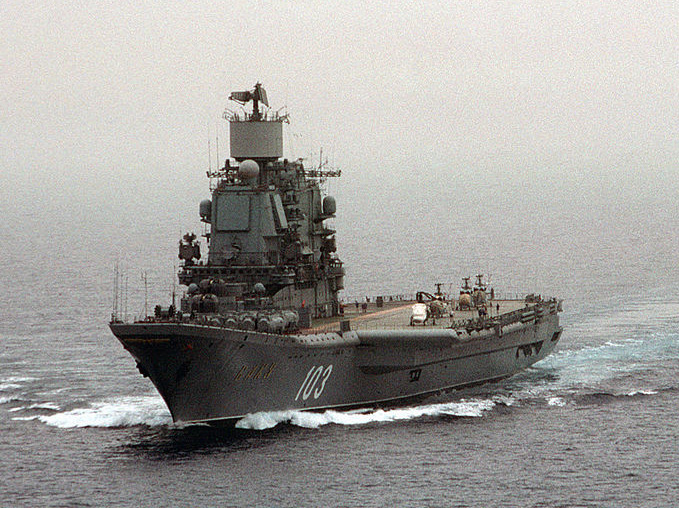
The Project 1143 Krechet, NATO Kiev class, were a group of four very large vessels built for the Soviet Navy, representative of the rapid buildup and trans-oceanic ambitions of the Navy in the late 1970s. They were intended to replace the 1960 generation helicopter carriers Project 1123 “Condor” (NATO Moskva class). Like the former they were hybrids, but this time with an angle deck and massive “island” making these unique hybrid ships without equivalent in the western world. Arriving at the same time as the Kirov class battlecruisers which they complemented as planned in the late 1960s, they were a first attempt at carrier-based aviation. They had various fates, two were purchased by China, one ended as a theme park/hotel, the other a museum ship, and Admiral Gorshkov, the last, was reconverted as a full-deck carrier for the Indian Navy as INS Vikramaditya. Only Novorossiysk was broken up.
Development
To go through the very root of the program for these very peculiar ships we have to look at the 1960s, when a program was setup to create a new fleet cruiser. In 1963-66 indeed, development of the Korshun universal missile system for long-range anti-aircraft defense started and equipped with at least two types of missiles, universal SAM/SSM and anti-submarine, gearing up to fire simultaneous 16 missiles on 8 targets. Eventually it was to be added to a “sidekick”, Project 1143 Krechet, an initial proposal to complement the Project 1144 Orlan long range combat ship, with the planned pair diverging, Project 1143 being reconfigured as more complete helicopter carrier, later which fused with another one, Project 1153 Orel, the first aviation-capable Soviet ship.

Interwar carrier projects
The Soviet Union already had a converted barge used as seaplane carrier in the 1918-1921 civil war, and by late 1930s, with naval aviation was developing, the priority was costal defence, not prower projection, and an aircraft carrier would just not fit in the first Five-Year Plans. Stalin however saw the interest of these ships and planned for two aircraft carriers until WW2 went into the way. In total four brand new carrier projects were started, none reached further than paper stage. They will be studied in a future dedicated page.
1950-60 projects
In the immediate post-war years USN carrier experience in the Pacific relaunched soviet interest for aircraft carriers but the economic realities of the time and recovery prevented any further work. In addition, until the 1970s land power in Eastern Europe was the priority however it resurface as early as 1951, pressed by Staling which also insisted on a new battlecruiser (The Stalingrad class). However after his death in 1953, the new premier Khrushchev fell in agreement with Admiral Kuznetsov about reducing defense spending, concentrating on smaller, more technologically advanced missile ships.
Aircraft carriers projects were all stopped. The premier saw indeed the expensive US conventional large carriers something already defeated by nuclear weapons. The drastic 1959 budget cut in conventional forces only confirmed this shift toward deterrence, until the economic situation improved enough in the 1960s to start thinking of an alternative, with Khrushchev still opposed to the idea. At last when he left office, work started under Brezhnev on a new class of hybrid helicopter ASW cruisers launched in 1965, the Moskva and Leningrad. Both were conventionally-powered and only carried anything else but helicopters. At least this helped opening a gap in the opposition. Next, came a reflexion on the use of a carrier-based air defense to round a fleet’s capability and in the early 1970s, this cristallized as Project Orel.
It was very ambitious indeed, as to provided the adequate organic fighter cover, was drawn the most ambitious design specification (TTZ) for a truly massive, 80,000 tonnes “soviet supercarrier” under Project OREL. It was to be nuclear-powered, having 70 jet aircraft with a multipurpose air wing but keep an impressive battery of dedicated antiship missiles but these compromises angered Defense Minister Grechko himself which advocated for a “pure” carrier in the US style, leaving the heavy missile battery aside. Too ambitious, costly and uncertain, Project Orel whent through two configurations before being cancelled. Its proponent, Marshal Grechko died, Marshal Ustinov became the new MoD and dismissed Grechko’s idea, while a “young school” inside the Navy looked at Europe and concluded that a smaller vessel carrying vertical takeoff/landing (VTOL) aircraft was more cost-effective for the type of fleet the Navy really wanted. This ended with a compromise design.
Project 1160, 1153, 1143M Orel
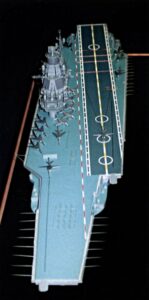 Project 1153 Orel (“Oryol”, “Eagle”) was conceived after Pr. 1143 Krechet, by the late-1970s for an added blue water aviation and set by TTZ at 72,000 tons displacement, equipped with a nuclear power plant with a full capacity of 70 aircraft and using a CATOBAR configuration, with steam catapults.
Project 1153 Orel (“Oryol”, “Eagle”) was conceived after Pr. 1143 Krechet, by the late-1970s for an added blue water aviation and set by TTZ at 72,000 tons displacement, equipped with a nuclear power plant with a full capacity of 70 aircraft and using a CATOBAR configuration, with steam catapults.
Project 1153 code “Eagle” was to be a “large cruiser with aircraft” rated at 70.000 tons and nuclear power plant in 1976 at the Nevsky Design Bureau, based on the unrealized project 1160, under chief designer was V.F. Anikiev.
In typical Soviet fashion it came with a proper very large offensive capability mounting 24 vertical launch tubes with anti-ship cruise missiles, SAM and CIWS. Also typically, they were called in Soviet naval nomenclature “large cruiser with aircraft armament”. Project 1153 ad itself derived from Project 1160 Orel, 10,000 tonnes heavier, but cancelled in October 1978 as too expensive. The new Project 1153 smaller was again believed to be too amibitious and expensive, and again, it was declined into a smaller vessel called Project 1143.5, this time V/STOL ship, which TTZ placed it in the 65,000 tons, 52 aircraft range.
After MoD Marshal A. A. Grechko died, the Minister of Shipbuilding B. E. Butoma, also supporter of the creation of aircraft carriers, and under insistence of D. F. Ustinov, the project became TAVKR 1143M (1143.4), the “Admiral Gorshkov” class. It evolved thus as Project 1143.3 Novorossiysk. Project 1153 ships were initially to enter service by 1985. The Air group comprised MiG-23K light fighters and Su-25K attack aircraft with a planned replacement by Su-27KI fighters and Su-27KSh attack aircraft and eventually Project 1143 was realized as the Kuznetsov class, a 55,000 tonnes STOBAR, known as the Ulyanovsk program in the 1980s.
Project 1143 Krechet
The project was essentially an interim carrier design, providing the fleet with a more affordable, les risky approach of an “evolutionary” design. It was still to provide a seagoing fixed-wing capability but was also a fully-fledged cruiser on a 40,000-ton displacement, conventionally-powered to further keep costs down.
…It’s amazing how the country’s leadership and the command of the Navy could afford, knowing about the billions of dollars in costs incurred during the construction of such ships with the efforts of the entire people, after a decade and a half, it was easy to sell them for scrap, receiving a penny at the same time.
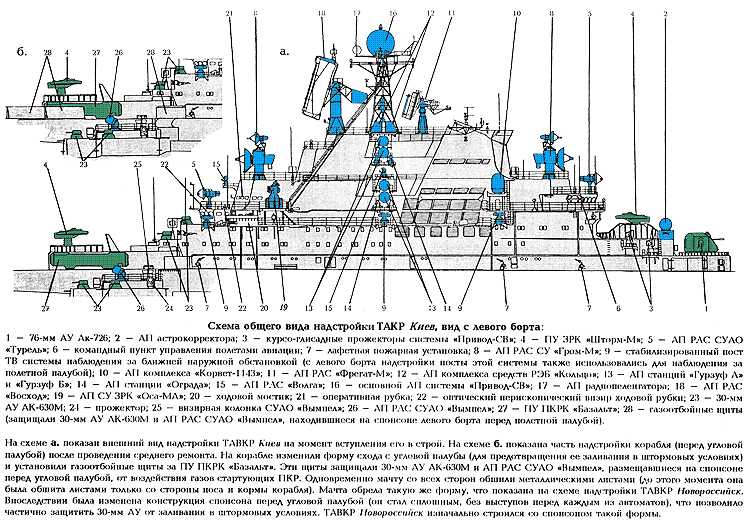
The drawings of the “Kyiv” under project 1143 by Nevsky PKB in Leningrad startred in accordance to the Resolution of the Central Committee No. 685-251 on 02.09.1968. Quite a long way to the completion of the fourth ship, Baku. Overall design work was headed by chief designer A.V. Marinich. She was a logical development of Project 1123 helicopter carriers and initially the design specified even a new class of anti-submarine cruisers. A total of 9 layout options were drawn, 6 according to technical requirements (TTZ) and three proposals on their own initiative, differing in architecture, armament placement and equipment. 32 further individual studies were carried out to assess the replacement of each weapon system with more promising systems. Based on these, the first option was chosen for further optimization.
On October 16, 1968, the Commander-in-Chief of the Navy, S.G. Gorshkov approved (the fouth Kiev ship will be name after him as homage to his contribution), technical specifications for what was still called at that stage an “anti-submarine cruiser” with aircraft, were approved. In appearance, the new ship leaned towards aircraft carriers as the superstructure was completely shifted to starboard while the flight deck was angled to 4.5° to the longitudinal axis and both section linked up at the large stern. One difficulty was structural, in order to manage a robust hull for at the same time a large sponsoned angled deck structure offsetting the hull and keeping the whole ship balanced. This was quite different that the approach taken for the Moskva class which just divided the hull in two with the ful aft end reserved for aviation. Such angled deck never had been seen on a Soviet Navy ship before, whereas it became all the rage on modernized 1950s carriers to operate jets, but in these case, the main “bulk” of the hull was taken by the utility part of the deck, not the island, which was sponsoned. Sponsoning such as massive island, while keeping the armament and sensors was just impossible.

The creation of the largest ship of the Russian fleet so far at that time also required a number of solutions two brand number and complex scientific and technical issue, which were successfully solved at the Central Research Institute A.N. Krylov and TsAGI. The aviation indeed was very much part of the solution and contributed much on many aspects. Project 1143 received the code “Krechet” when approved by the fall of 1969 by the Navy and Ministry of Shipbuilding, on April 30, 1970.
Construction
The lead ship was built in Nikolaev, Black Sea Shipyard. The modernization of this yard was necessary, with the Northern and Western areas, two new, very large drydocks were created, down to 11.25 meters. Due to the rocky soil, the planned 16 meters was never achieved indeed, it was decided to build new outfitting basins for new aircraft carriers and having all the necessary infrastructure. For their passage to open sea, considerable dredging work was carried out at the Bug-Dnieper Estuary Canal with a brand new mechanical assembly workshop and two special wheeled trailers purchased from Germany just to transport large modules at 300 tons. On the slipway, the two older tower cranes were replaced by higher lifting ones capable of 75 tons.
The Black Sea Shipyard also produced a life-size model with a full section of the flight deck and a test bench created at the Flight Research Institute of Zhukovsky to test water and air resistance. On July 21, 1970, “Kyiv”, was laid down at the large slipway (No.0), largest in Europe at that time. Construction was carried out by dividing her into no less than construction areas for a modular approach, very unique at the time. The slipway assembly was pyramidal, from pre-assembled sections, welded on site, near the slipway. On average, 1,500 worked daily on the construction which was aimed to shortening construction time of a year.
Kiev was launched on December 26, 1972, outfitted while construction of her sister Minsk commenced already at the Black Sea Shipyard, plant No. 102. In July 1974, mooring tests for fire protection and main power plant started and by October 1974 to April 1975 the entire ship was tested. She was at last commissioned on April 15, 1975, and two days later, left the yard for her initial yard sea trials off Sevastopol followed by state trials. Despite all the measures taken, construction of the led ship lasted 5 years, 5 months, and 5 days exaclty. Her sisters were built a tad faster:
Minsk…
Design of the class
Unlike most NATO aircraft carriers, the Kiev class very uniquely combined a cruiser (seen from profile, fully fledged, not hybrid) as well as an aircraft carrier with a large offset deck. The Soviet Navy at the time still designated this ship as a “heavy aviation cruiser” focused mostly on ASW, but also air coverage of the fleet, not an “aircraft carrier” per se, which was still in the works. This designation was legally important that it provided the Russian Navy the right of transit through the Turkish Straits, which since the 1936 Montreux Convention prohibited aircraft carriers heavier than 15,000 tons entering the Dardanelles.
The Kiev class harbored a large island superstructure starboard and the angled took flight-deck 2/3 of the total length. The ship’s foredeck was occupied by heavy surface-to-air and surface-to-surface missile armament not unlike the Kirov class, albeit without VLS. The ship was originally intended to search and destroy submarines, but it was amended later for more cooperation with other naval forces. One of the mission determined later was to allow support, over the horizon data link for ballistic missile submarines, as well other surface ships and naval aviation, but still be capable to defend itself, against a mix of antiaircraft, antisubmarine, and surface threats of needed, independently of its air group. It was to provide full protection of naval formations from air strikes, their anti-submarine and anti-boat support, ensuring the safety of Soviet SSBNs in combat patrol areas and initial deployment, cover for detached naval land-based aircraft within reach of friendly fighters by its own VTOLs, but also search and destroy enemy submarines as part hunter-killer ASW groups, and in the end, defend the fleet against enemy surface ships as well as providing the air component of amphibious landings (see later).
All plans and blueprints were prepared by the Design Bureau Nevskoye which also planned construction, whereas the chosen builder for the lead vessel was Nikolayev South (formerly Chernomorsky Shipyard 444). It was still possible in the future to have them converted as full carriers, as shown Vikramaditya later, at least of the northern, Pacific and Baltic fleets.
Kiev Class Carrier by Joji_Discord on Sketchfab
Hull and general design
The ship had a high freeboard hull made of steel of AK-25 and AK-27 types and using a longitudinal framing system and transverse one with 500 mm spacing. The hull was divided into 18 compartments closed by transverse bulkheads and two longitudinal, waterproof partitions planning buoyancly even if 4 adjacent compartments were flooded below the waterline. The hangar also participated in this buoyancy as it was fully sealed. Engineeers at the time reported the ship remained “unsinkable” even if water reached the 5th deck. The middle part of the hull was crossed by six decks and two platforms. The Kiev class became the first Soviet aircraft-carrying ship having a full flight deck 189 m in lenght and 20.7 m in width for a total area of 5,600 m2.
The flight deck was covered with special heat-resistant AK-9F plates. The 9-tier superstructure shifted to the starboard side is still cut short aft to leave free the third tier to parking and the main lift. The superstructure is made of AMG aluminum-magnesium alloy as part of the measures to reduce overweight. To reduce radar signature, all vertical surfaces of the superstructures were inclined up to 10° as an early stealthy measure, but the decreased weight up to the top also participated in top weight savings as well. As seen above, the Kievs were the largest ships ever built by Russia, with an overall length of 273 m (896 ft), so far more than the Kirov class battlecruisers, overall and even 283 m (928 ft) for the lakst of the class, Project 11434 Baku.
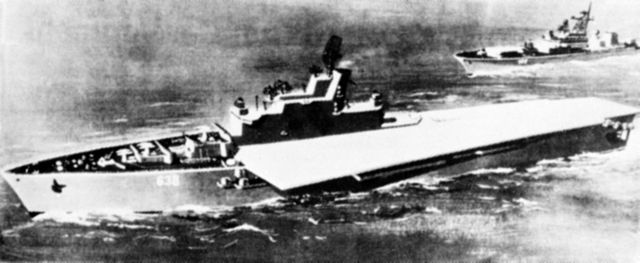
US Dod Artist Impression of the Kiev class in 1975
The overall width at the flight deck was 53 m (174 ft) making these also the largest ships ever built since the Vidze Admiral popov round ships (38 m) a century prior. The true beam however was inferior, at 32.6 m (107 ft) at the waterline, still more than the Kirov class or the 1950 Stalingrad class. As a result they displaced no less than 43,000–45,500 metric tons full loaded, and again, heavier than any ship built prior, including the Kirovs and their meagre 28,000 tonnes. Only the cancelled Stalingrad class came close. Another aspect to keep stability was the addition of two rudder planes which were automatically controlled to prevent pitching and rolling, and basically were a repeat of the system installed on the Moskva class and these additional angle counterkeels depended on motion in adverse conditions. The roll control system was automated by the Rul-63 control systems, activating this pair of rudders and flaps capable of a full angle traverse in 15 seconds. This was monitored remotely from an external post. Like for the Moskva, this system, oversized in that case, helped keeping the deck stable even in northern water stormy conditions.
As for protection, it was not pushed as far as on the Kirov class cruisers, there was a good subdivision against ASW flooding, redundancy in the engine room, thermal protection of the deck (see below), protection of the ammunition stortage rooms, of the avgas tanks but no proper armour, but for the middle of the 3 longitudinal bulkheads, armoured, details unknown, as well as aviation fuel tanks and magazines which had “box protection”.
The ships relied more on their SAMs for anti-ship work, decoys, jammers, and CIWS at the last extremity. However there was a full NBC protection as well, made accordingly to the anti-nuclear protection requirements that existed at that time. It was capable of protecting the crew even in case of a 30-kiloton nuclear charge detonating at a mere 2 kilometers or 1.24 mile ! All access doors and hatches to the exterior were sealed, as well as internal access hatches in the 18 section bulkheads, plus both radiation and chemical detection, an external warhing system, and internal overpressure system by the air conditioners.
Powerplant
The main power plant was to be considerable for such a mass it was simple a “doubled” version of the one previously used on Project 1123 Kondor (Moksva class). This powerplant was divided into two echelons, included no less than eight KVN-98/64 steam boilers and four GTZA TV-12-3 turbines. Four-bladed bronze propellers were used as propellers. The source of electricity was 6 turbogenerators and 4 diesel generators with a total capacity of 15,000 kW.
The eight boilers were turbopressurized at veay high temperature and pression, whereas the four steam turbines were fully geared and staged between two high and lower pressure chambers, rated in total for 200,000 shp (150,000 kW)). Here again, a record for a conventioally powered ship of the Soviet Navy. It came with four shafts with four-bladed propeller screws, and a top speed of 32 knots (59 km/h; 37 mph) ideal for fleet manoeuvers.
To power the ship in case of failure and at anchor, the Kiev class also had on board four main turbo-gear units, TV-12-3 type still enabling a top speed of 30.7 knots if needed. They were fed in turn by six turbogenerators and four diesel generators, total capacity 15,000 kW. They were located in compartments adjacent to the turbines, two for each turrbine. The installation, power generation susytem and main distribution boards, displays, calme directly from Project 1123 ships. The Terek-2 was the unified large control dusplay for the entire powerplant, and it was automated. To lower the risk of acoustic detection, the Kiev class had, like the Moskva, a Cushioning of most vibration-prone elements of the powerplants, and it was compouded with heavy use of insulating coating, especially in the main engine rooms.
Armament
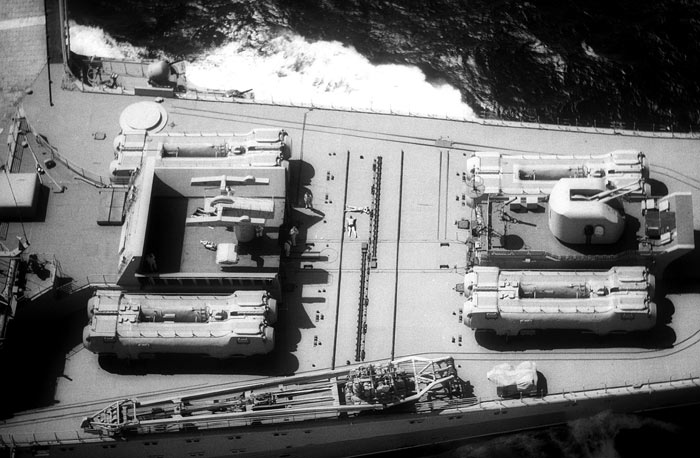
Photo showing the concentration of armament on the forward deck, from top left, to bottom right: two AK-630 CIWS guns with MR-123 radar, a ZIF-122 launcher for the Osa-M air defense system, an Uragan-1143 missile system, a B-189 Shtor air defense system launcher, and AK-726 main guns. src razgromflota.ru
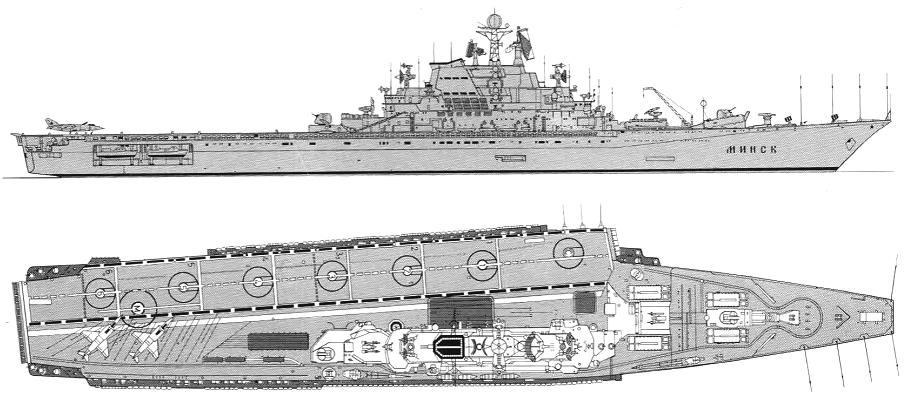
Minsk 1990
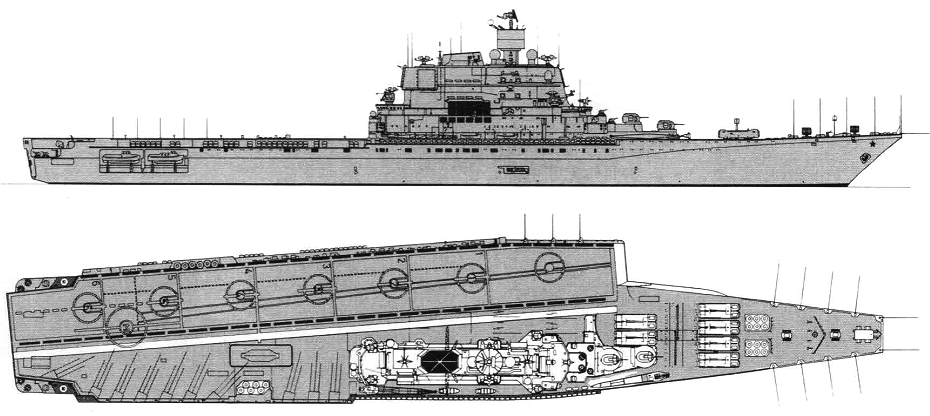
Admiral Gorshkov 2004, for comparison – src navypedia
The Kiev’s armament comprised in order, four twin launchers for the P-500 “Basalt” long-range anti-ship missiles (16 missiles), two twin launchers for the M-11 “Storm” air defense system (96 missiles in store), two twin launchers for the “Osa-M” air defense system (40 missiles) and well as two RBU-6000 (120 RSL-60 depth charges) to deal with close submarines, and two 533-mm torpedo tubes PTA-53-1143 with 10 SET-53 or SET-65 torpedoes, all acoustic and long range for ASW or surface warfare. But this differed over time and ships:
Kiev and Minsk (Project 1143):
4×2 P-500 Bazalt SSM launchers (8 missiles)
2×2 M-11 Shtorm ASW/SAM launchers (72 missiles)
2×2 9K33 Osa launchers (40 missiles)
2×1 AK-726 twin 76.2 mm AA guns
8×1 AK-630 30 mm close-in weapon system (CIWS)
2×5 21″ torpedo tubes
1×2 SUW-N-1 FRAS Anti-Submarine Rocket launcher
Novorossiysk (Project 1143M):
4×2 P-500 Bazalt SSM launchers (8 missiles)
2×2 M-11 Shtorm ASW/SAM launchers (72 missiles)
No Osa SAM launchers
2×2 AK-726 twin 76.2 mm AA guns
8×1 AK-630 30 mm CIWS
No torpedo tubes
1×2 SUW-N-1 FRAS antisubmarine rocket launcher
Baku (Project 11434):
6×2 P-500 Bazalt SSM launchers (12 missiles)
24× 8-cell 9K330 Tor vertical SAM launchers (192 missiles)
2× 100 mm guns
8× AK-630 30 mm CIWS
2×5 21″ torpedo tubes
2× RBU-6000 antisubmarine rocket launchers
P-500 Bazalt
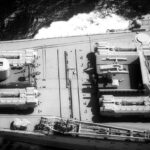 The P-500 Bazalt were dependable bu crude turbojet-powered, supersonic cruise missiles. Their GRAU designation was 4K80, NATO reporting name SS-N-12 Sandbox (no change as came the upgraded P-1000 Vulcan AShM SLCM). Initially designed as “carrier killer”, and also deployed on the Slava class cruisers. They had a 550 km range, 1,000 kg payload for either a 350 kt nuclear, or 950 kg semi-armor-piercing high-explosive warhead. It used active radar homing in terminal guidance, but was setup to received over the horizon mid-course corrections, coming from Tupolev Tu-95RTs Bear D, or a dispatched Kamov Ka-25K Hormone B or Kamov Ka-31 in the case of the Kievs, since they had their own park.
The P-500 Bazalt were dependable bu crude turbojet-powered, supersonic cruise missiles. Their GRAU designation was 4K80, NATO reporting name SS-N-12 Sandbox (no change as came the upgraded P-1000 Vulcan AShM SLCM). Initially designed as “carrier killer”, and also deployed on the Slava class cruisers. They had a 550 km range, 1,000 kg payload for either a 350 kt nuclear, or 950 kg semi-armor-piercing high-explosive warhead. It used active radar homing in terminal guidance, but was setup to received over the horizon mid-course corrections, coming from Tupolev Tu-95RTs Bear D, or a dispatched Kamov Ka-25K Hormone B or Kamov Ka-31 in the case of the Kievs, since they had their own park.
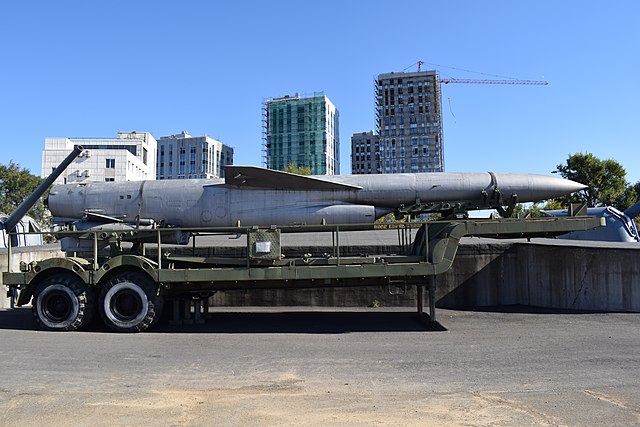
These missiles were intended to be used in salvos with datalink, and when in flight, they were able to co-ordinate their actions, one deployed at a higher altitude as “recce” for the others at low altitude to be kept under radar beam if needed, but they could also use deceptive tactics. This was a very advance tech for the 1970s Soviet Union as NATO as nothing of the sort. They stayed relevant for the whole career of these ships, upgraded to the P-1000. There was a crane to reload these in case, as there were another 8 spare missiles stored inside. In general two sets of two pairs were arranged on the forward deck, but another center pair was added on Baku, they were rearranged with the removal of the Gecko SAM.
M-11 Shtorm SAM
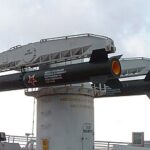 The M-11 Shtorm (“Storm”) was a surface-to-air missile system (GRAU 4K60; NATO SA-N-3 Goblet) installed on Kiev, Minsk and Vovorrossysk. These not officially accepted until 1969 with a development starting on 25 July 1959 by the Scientific Research Institute 10 (NII-10) until 1966. The standard launch platform used a twin rail naval Mount with below deck magazine. The missile along weighted 1,844 kg (4,065 lb) for 610 cm (240 in) long, carrying a 80 kg (180 lb) warhead to 30 km (19 mi) or a ceiling of 25,000 m (82,000 ft) at Mach 3. It was seen as rough equivalent of the USN Talos. They were located on an upper platform in between the P-500 basalt tubes, with a large fire deflector behind to protect the superstructure.
The M-11 Shtorm (“Storm”) was a surface-to-air missile system (GRAU 4K60; NATO SA-N-3 Goblet) installed on Kiev, Minsk and Vovorrossysk. These not officially accepted until 1969 with a development starting on 25 July 1959 by the Scientific Research Institute 10 (NII-10) until 1966. The standard launch platform used a twin rail naval Mount with below deck magazine. The missile along weighted 1,844 kg (4,065 lb) for 610 cm (240 in) long, carrying a 80 kg (180 lb) warhead to 30 km (19 mi) or a ceiling of 25,000 m (82,000 ft) at Mach 3. It was seen as rough equivalent of the USN Talos. They were located on an upper platform in between the P-500 basalt tubes, with a large fire deflector behind to protect the superstructure.
9K33 Osa launchers
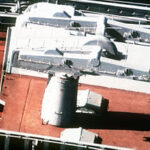 The missiles were installed only on the first two, Kiev and Minsk. They were placed in single launchers with revolver holders below deck. These missiles were designed to protect the ship from attacks by longer range aircraft and cruise ships missiles. Specs of the full launcher: length 7.9 m, diameter 0.34 m, weight 1600 kg speed up to 2000 m/s, range up to 75 km and up to 25 km in altitude. Weight 170 kg, 3,158 x 2,096 m wingspan, Solid propellant dual-thrust rocket motor, 2s boost, 15s sustain, 1020 m/s at 12,000 metres (39,000 ft), range 15 kilometres (9.3 mi) guided by RF CLOS, with an accuracy of 5 m and carrying a payload of 16 kg Frag-HE with Contact/proximity fuse.
The missiles were installed only on the first two, Kiev and Minsk. They were placed in single launchers with revolver holders below deck. These missiles were designed to protect the ship from attacks by longer range aircraft and cruise ships missiles. Specs of the full launcher: length 7.9 m, diameter 0.34 m, weight 1600 kg speed up to 2000 m/s, range up to 75 km and up to 25 km in altitude. Weight 170 kg, 3,158 x 2,096 m wingspan, Solid propellant dual-thrust rocket motor, 2s boost, 15s sustain, 1020 m/s at 12,000 metres (39,000 ft), range 15 kilometres (9.3 mi) guided by RF CLOS, with an accuracy of 5 m and carrying a payload of 16 kg Frag-HE with Contact/proximity fuse.
9K330 Tor VLS SAM
The Tor (NATO SA-15 Gauntlet) was operational in 1986 and installed on Baku alone. This was a short-range Air Defense (SHORAD) system, smaller but more efficient with a better range and accuracy compared to the 9K33 Osa. It carried a Warhead with 15 kg high-explosive fragmentation (9M331) and is capable of a range of 12-16 km. Twenty four in VLS composed of 8-cell 9K330 vertical SAM launchers (192 missiles), with two forward on the deck, in front of the Bazalt SSM and a single one aft of the island starboard.
AK-726 twin 76.2 mm AA guns
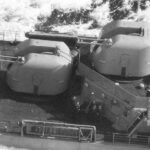 Two twin turrets installed one forward, in between the Bazalt SSMs, and one aft of the island. Shell weight 5.9 kg (13 lb) 76.2 mm (3 in), Sliding wedge breech, semi-automated with +85° elevation, 40–45 RPM per barrel, mv 980 m/s (3,200 ft/s), max range 15,700 m (17,200 yd) ceiling, 11,000 m (36,000 ft), self-destruct fuses.
Two twin turrets installed one forward, in between the Bazalt SSMs, and one aft of the island. Shell weight 5.9 kg (13 lb) 76.2 mm (3 in), Sliding wedge breech, semi-automated with +85° elevation, 40–45 RPM per barrel, mv 980 m/s (3,200 ft/s), max range 15,700 m (17,200 yd) ceiling, 11,000 m (36,000 ft), self-destruct fuses.
AK-630 30 mm CIWS
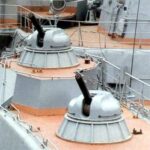 Close-in weapons systems, also capable of antiship missile fire. Ammunition capacity of 16,000 rounds, 2,000 rounds per belt) are designed to destroy air targets, anti-ship missiles, small ships, pop-up mines and lightly armored ground targets. The initial speed of a projectile with a diameter of 30 mm, weighing 0.39 kg reaches 900 m/s, rate of fire is 6000 rounds/min, range is up to 8 km.
Close-in weapons systems, also capable of antiship missile fire. Ammunition capacity of 16,000 rounds, 2,000 rounds per belt) are designed to destroy air targets, anti-ship missiles, small ships, pop-up mines and lightly armored ground targets. The initial speed of a projectile with a diameter of 30 mm, weighing 0.39 kg reaches 900 m/s, rate of fire is 6000 rounds/min, range is up to 8 km.
SUW-N-1 FRAS
 The RPK-1 Vikhr (“Whirlwind”) (GRAU 82Р, NATO FRAS-1) is a Soviet ship-based anti-submarine missile system adopted on June 12, 1968, studied 1960-66. So it was also inaugurated by the Moskva class. It has an inertial guidance system. It carried a tactical nuclear warhead (5/10 kt) with complete obliteration at any target over a 1.2 to 1.5 km radius.
The RPK-1 Vikhr (“Whirlwind”) (GRAU 82Р, NATO FRAS-1) is a Soviet ship-based anti-submarine missile system adopted on June 12, 1968, studied 1960-66. So it was also inaugurated by the Moskva class. It has an inertial guidance system. It carried a tactical nuclear warhead (5/10 kt) with complete obliteration at any target over a 1.2 to 1.5 km radius.
Weight of the missile 1800 kg, 6.00 m long, 0.540 m diameter, Solid fuel engine, Range 10-24 km. The alternative was a 450 mm (18 in) non-homing torpedo. This was the “ultima ratio” against any USN sub -provided the sonar picked it up. The system was dependent of the Sprut fire control system (PUSTB-1123) developed by CDB-209, comprising a central control unit (TSPUS), Tiphon fire control computer, Gyro stabilisers, Link to the sonar system and Remote power control. It was located immediately after the RBU rocket launchers forward.
RBU-6000
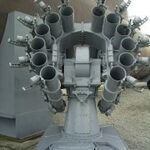 A “classic” already covered in other articles. Installed only on Baku, later Admiral Gorshkov: They were located forward on deck, close to the bow. Weight: 3,100 kg (empty), 2 m long, 2.25 m height 1.75 m width, -15° to +65° elevation and 180° traverse. Fires the RGB-60, 0.212 x 1.83 m, 113.5 kg, Warhead 23 kg, range 350 m to 1700 m or 1500 m to 5500 m, depth capacity 500 m with 11.6m/s sink rate.
A “classic” already covered in other articles. Installed only on Baku, later Admiral Gorshkov: They were located forward on deck, close to the bow. Weight: 3,100 kg (empty), 2 m long, 2.25 m height 1.75 m width, -15° to +65° elevation and 180° traverse. Fires the RGB-60, 0.212 x 1.83 m, 113.5 kg, Warhead 23 kg, range 350 m to 1700 m or 1500 m to 5500 m, depth capacity 500 m with 11.6m/s sink rate.
2×5 Torpedo Tubes
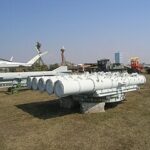 These quintuple torpedo tubes banks PTA-53-1123 using remote-controlled electric servo drive with backup manual drive. The rotating platform enabled loading, aiming and traveling with fire control firing data into the torpedo, of the SET 53-65K type. It was a pneumatic launch as powder charge was judged too risky.
These quintuple torpedo tubes banks PTA-53-1123 using remote-controlled electric servo drive with backup manual drive. The rotating platform enabled loading, aiming and traveling with fire control firing data into the torpedo, of the SET 53-65K type. It was a pneumatic launch as powder charge was judged too risky.
The SET-53-65K entered service in 1969, weighting 4,563 lbs. (2,070 kg) for a lenght of 283 in (7.200 m), carrying a 661 lbs. (300 kg) warhead (conventional/nuclear). It was powered by a Kerosene-Oxygen Turbine at 20,800 yards (19,000 m)/45 knots.
Sensors

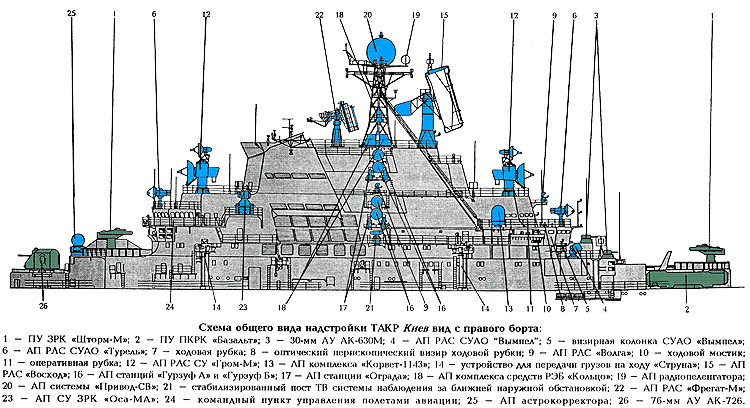
The Electronic suite of course changed a lot during the final design phase, and until completion, undergoing significant changes. While maintaining initial systems such as the MR-600, Gurzuf, Orion sonar (bow bulge), Project 1143 ships received a seto fo brand new and long range systems, untested. The previous three-dimensional airborne surveillance radar “Angara” was replaced by the more advanced station “Fregat” radar. It was also necessary to install for the first time on the lead ship, the Typhoon-1 and Tsunami-BM communications complexes as well as the Salgir-1143 navigation complex and Caspian control system, as well as the Privod-SV, and Aist systems “K” and “Lazur”, plus the “Uragan-1143” suite for a grand total of 24 main sensors and elevtronics complexes, also unrivalled at the time. One of the most promising for ASW was the towed sonar “Platina” installed in the lower deck.
One of the innovations of the time was to manufacture and instal a sound-transparent and durable radome of for the main 3D radar antenna with a diameter of 8.4 m.
There was a fully automated system for collecting and processing information and privide target designation and decision-help, called the “Alley-2” which also help to guide helicopters. The hydroacoustic long-range detection station was intended to track high-speed US SSNs, called MG-342. It was completed by the hydroacoustic complex “Platinum” a passive sonar of the sipping type, receiving data tranmissted the RGAB MGS-407K system submarine detection station using thermal contrast. There were also torpedo wake detection systems such as the MI-110K, MI-POR, and the three-dimensional noise-immune long-range airborne detection radar MR-600.
Aerial targets could be picked up by a massive three-dimensional, noise-resistant radar of the “Fregat” type, with automated processing of radar information, working with the target designation system “Baikal-1143” and identification (IFF) system “Kremniy-2M”. It was completed for surface combat with the marine target designation system MPTs-301 and the navigation radars “Volga” and “Vaigach-1143”.
The Kiev class also came with the Salgir-1143 navigation system working with two echo sounders (NEL-6 and NEL-10) in shallow waters, an automatic map data reader, and the automated communications complex “Typhoon-1” which encypted long range information, using 14 KB and two SV radio transmitters as well as a 21 KB and one SV and SDV radio receivers plus no less than 13 VHF radio stations.
There were three radio receivers of the R-678N type, six of the R-670M type and two of the R-721 type and the wide-view VHF receivers R-710 and R-714 as well as the a radio jamming system (VHF) R-740K.
To detect targets visually at long range the bridge was provided with two sets of panoramic sights SRS-2. The ship was equipped with automated systems for short-range navigation, drive and landing helicopter, the Privod-SV. A central computer managed all data from radars and provided via several displays a full picture of the situation. There were also the electronic countermeasures systems “Gurzuf” and “Gurzuf-1”.
The suite diverged between ships again: The first two of Project 1143 from the third, Project 11433 and the fourth, Baku, as Project 11434:
Project 1143 (Kiev, Minsk):
-MR-700 Fregat-M main 3D surveillance Radar
-MR-600 Voskhod Radar
-Volga Radar
-MR-212 Vaygach-1143 Radar
-Argon-1143 Radar
-2x Grom-M Fire control radars
-2x 4R-33, MR-105 Turel Fire control radars
-4x MR-123 Vympel-A Fire control radars
-Gurzuf, Gurzuf-1 ECM suite
-MR-262 Ograda ECM suite
-Koltso ECM suite
-Towed Sonar MGK-335 Platina
-Main active bow sonar MG-342 Orion
-MGS-407K passive sonar
-MI-110R, MI-110K wake detectors
-2x PK-2 decoy Rocket Launchers
Alleya-2 Jamming and Counter Measure System
Project 11433 (Novorossiysk):
-Radar MR-700 Fregat-M
-Radar MR-600 Voskhod
-2x Fire control MR-350 Podkat radars
-Radar Volga
-Radar MR-212 Vaygach-1143
-Radar Argon-1143
-2x Grom-M Fire control radars
-MR-105 Turel’ radar
-4x Fire control radar MR-123 Vympel-A
-Kantata-M ECM suite
-MR-262 Ograda ECM suite
-Koltso ECM suite
-VDS MGK-335 Platina
-Hull active sonar MG-355 Polinom
-MGS-407K semi active retractable sonars
-MI-110R, MI-110K wake detectors
-2x PK-2 decoy Rocket launchers
-Alleya-2K Jamming and Counter Measure System
Project 11434 (Baku – Gorshkov):
-Mars-Passat radar suite
-MR-700M Fregat-M1
-2x MR-350 Podkat fire control radars
-Volga Radar
-MR-212 Vaygach-1143 radar
-Argon-1143 radar
-4x 3R-95 fire control radars
-MR-145 Lev-218-100 control radar,
-4x MR-123 Vympel-A control radars
-Rezistor-K4 FCR
-Tur & Gazon fire control radars
-MP-502 Kantata-M ECM suite
-MP-407 Start-2 ECM suite
-MG-355 Polinom VDS sonar
-4x PK-2 decoy Rocket launchers
-MVU-410 Lesorub-434 countermeasure system
Communication and other systems
-Communication and radio equipment included the following:
-BIUS “Alley-2” communication and data link
-Navigation complex “Salgir-1143”
-Satcom communication system “Typhoon-1”
-Landing system “Privod-SV”
-Electronic warfare equipment “Koltso” and “Ograda”, PK-2
Facilities
They diverged between ships:
Project 1143 Kiev, Minsk
The overall “flight deck” measured 273.1 x 49.2m and with 189m of useful offset flight deck, which represented a total of 11,000 m². The hangar measured 130 x 22.5 x 6.60 m for a total area of 2,925 m² and 19,305 m³ in volume. Initially there were one, then two lift, one large for helicopters at the foot of the island amidship, a small ammunition one forward of it, and another aft of the island, narrow for the Yak-38, wings folded, plus three more smaller lifts for weapons. Aircraft fuel stowage was a total of 1,200 t of jet fuel. Innovations concerned the full area hangar floor, not supported by pillars and covering this area, but also on deck, the special heat-resistant coating setup to protecting it from 1000°+ gas jets for these VSTOL aircraft.
Fire safety as well as operational maintenance for aviation weapons became paramount, with separated lifts to bring up all sorts of payloads, and studied to divert air flows above the upper deck and create most favorable conditions for takeoff and landing.
In fact, in 1972, according to documentation, a full-scale replica of the runway section was made at LII airfield and a Yak-36M was tested on it, making a serie of engine tests to determine both the power and thermal effects on deck, as well as measuring noise levels below deck for insulation. The very first launches resulted in severe warping of the steel deck section leading to modifications and new tests. Thermal insulation also needed new solutions, provided by the All-Union Institute of Aviation Materials which developed a new specific heat-resistant coating of the AK-9F type.
Project 11433 Novorossysk
Albeit still represneting a total of 11,000 m² the flight deck was pushed overall to 51.3m in width. The hangar was exactly the same however, and with the same elevators. Aircraft fuel stowage however was increased massively to 1,800 t of jet fuel, something learned from the first exercises.
Project 11434 Baku
The Flight deck was the same as above, as was the hangar, but the elevators changed, as a result of deck operation experience: Now there was a 30t forward lift, 18.9 x 10m in size, at the same placed as before, and a larger 20t aft 18.9 m long by 4.8m wide lift approximatily placed were the former was. Superstructure was more compact and missed its “tail end”, feering extra deck space. The Aircraft fuel stowage was compromised to 1500 t of jet fuel.
The flight deck had a two-level sponson, with a total area of 6,200 square meters, for the main takeoff area and landing strip. It received seven take-off and landing spots both for VTOL aircraft and helicopters. There was ample room in between them, so in an amphibious operations, troops could rush to these and the ship launch a first wave of seven helicopters, while the new ones, were either parked nearby and pushed to the flidh deck and/or brough up by the lift. On starboard, aft the flight deck ten more positions were installed for the presonal servicing flight equipment.
Project 1143, had room for 22 aircraft, in two configurations, airplane or helicopter. All were stored in a single-tier hangar and it was served by the larger lift close to the island being used for rapidly lowering any helicopter or aircraft into the hangar, the second one for lifting these, thus ensuring a rapid rotation in operations. The design capacity of the hangar was 2 aircraft in front, but after a visit on Kiev by Minister of Defense Marshal A.A. Grechko, he demanded an increase in aircraft 1/2 times, and the layout of the hangar was revised. The minister also lifted the ban on a mandatory gap of 0.75 m between them, allowed these to be parked externally on deck also, while the hangar capacity was increased to 36 aircraft of all types.
The control of airplanes/helicopters operations on deck was carried out by special tractors, whereas in the hangar under the rood wre located several longitudinal-transverse towing systems. The hangar was sealed, and thus, equipped with powerful ventilation systems with automatic shutdown in case of fire. It was also associated with heat sensors and sprinklers, but could detect concentrations of jet fuel vapors, and completed by foam type fire extinguishing and alarm systems. In addition five retractable asbestos fire curtains could help divide the hangar into six manageable zones.
Unlike American practice, composition of the air group was not fixed and was task-based. In full aviation mode, these ships carried ideally board 20 VTOL aircraft aboard, assisted by two rescue helicopters, or in the full helicopter version, some twenty Ka-25PL plus the same two rescue helicopters. To ensure long operations, large reserves of aviation fuel were stored on board in separate tanks buried inside the hull. The Yak 38 and helicopters were provided in case in a special hold, RN-28 bombs (tacticall, nuclear), as well guided and unguided missiles and disposable bomb clusters plus air to air missiles. Separated holds accessessed to the deck by their own tailored lifts.
Air Group
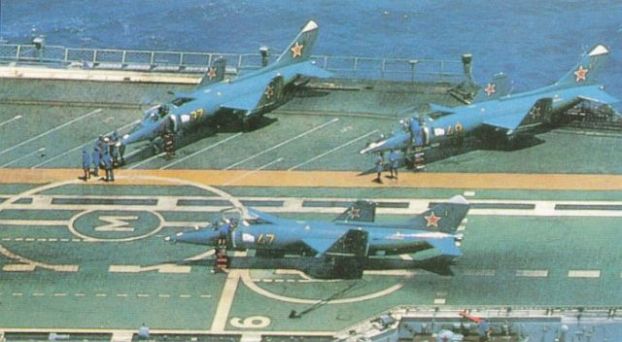
These varied a lot: 22 aircraft (Yak-38M attackers, Ka-25PS helicopters) for Kiev, 33 of the same for Minsk, due to several modifications. And 36 also but with more modern Ka-27, Ka-27PS helicopters for the third ship, Novorrossysk.
In practice, the composition as said already was mission-dependent. On her first deployment, Kiev only carrier five Yaks and no helicopters, to validate the “forger” before more deployments. Assigned to the northern fleet she was to escort SSBNs to the GIUK gap. When ready for her 1977 deployments she deployed 13 Yak-38M and 2 Ka-25PS plus 3 Ka-25Ts, respectively for SAR and ASW.
Minsk in 1978 as completed carried a “full monty” of fourteen 14 Yak-38M and sixteen multirole Ka-25, plus two Ka-25Ts for ASW and two Ka-25PS for SAR.
Novorossiysk freshly commissioned in 1982 sported sixteen Yak-38M and eighteen 18 Ka-27, plus only two Ka-27PS (SAR).
The fourth Project 1143.4 ships Baku, as modified to carry more aviation, but two less than Novorrossysk so 34 aircraft between Yak-38M and Ka-27/27PS helicopters. In 1990 close after completion, she only carried twelve Yak-38M and 16 Ka-27 multiroles, as well as two Ka-27PS for SAR, and two Ka-25Ts for ASW.
VSTOL aviation
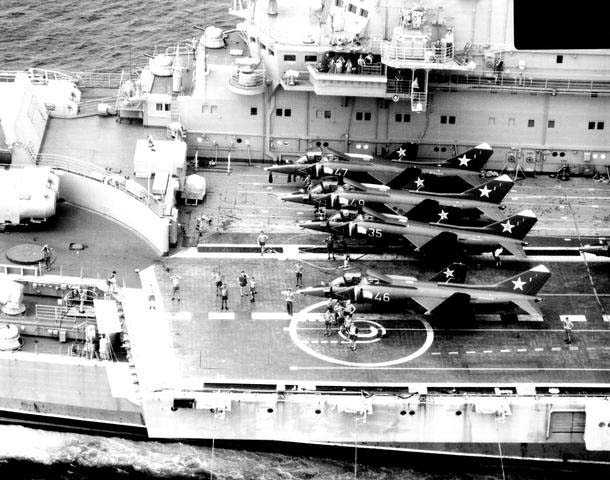
Experts had far from clear opinions about capabilities of VTOL aircraft at the time, Britain seemingly mastering the type and both Germany and France trying but not adoption it. Back in 1969, the Harrier was barely out of tests, with the prototype making its maiden flight on 28 December 1967, very little time before Project 1143 was approved, and it was introduced from 1 April 1969. Western experts stil saw the VTOL formula very interesting in many cases as it was a promising, less expensive alternative to classic horizontal take-off and landing models which needed a massive space to take off and lainding.

Yakovlev Yak-38 “FORGER” “yelow 60” Khodynka Aerodrome, Moskow 1991. Author’s illustration
On the other hand, VTOL were still in their infancy at the time, with barely enough power to lift off the ground, let alone taking onboard a heavy payload, as well as dangerously unstable, requiring above average and well trained pilots. This design was also deficient in other flight characteristics and notably top speed. It was D.F. Ustinov (Secretary of the Central Committee for Defense Industries) that pushed for the idea as soon as Soviet spies in UK reported the first flights of the Hawker Siddeley Harrier. For the Commander-in-Chief, Fleet Admiral S.G. Gorshkov, limitations were there, but he did not object to pursue development of a Russian VTOL. The prospect of the fleet receiving jet aircraft on a relatively small displacement was indeed for him to good to miss, since for a single US supercarrier it was estimated to be able to crank out up to four Kiev class, with the added bonus of a proper firepower such supercarrier could only dream about. It would create in any case the much-needed ship-based naval aviation the Soviet Navy needed for power projection, the type of ship was was sorely missing during the Cuban crisis.
The first landing Kiev was performed by a Yak-36M on May 18, 1975 (test pilot O.G. Kononenko). Kiev was to come with a first permanent park of five VTOL aircraft Yak-36M plus a twin-seat training Yak-36MU at first. She started her first deployment in the North route around Europe on July 16, 1976 to the Northern Fleet from Sevastopol, via the Bosphorus and Dardanelles and in Mediterranean Sea, Crete, started her first scheduled flights with Yak-36M and performed 45 flights, 22 hours, showing these were short hops. This was followed by the Sever-77 exercises until April 19, 1977.
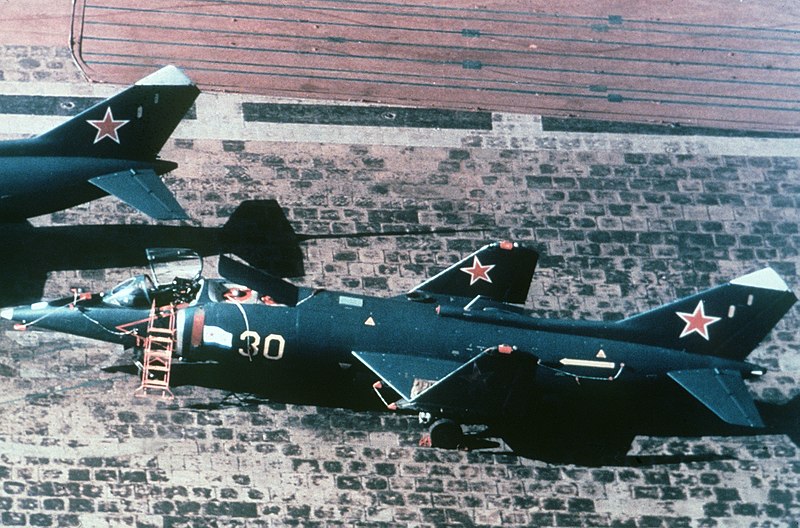
It’s only by August 1977, that the Yak-36M was officially adopted by Soviet Naval aviation under the designation Yak-38 (NATO Forger). Her short wings folded using separate hydraulic drives and equipped with pin locks once unfolded to take off. Initially, her undercarriage track once deployed was only 2.2 m, judged not enough to prevent accident for sch an unstable machine. Engineers at Yakolev changed the design of the shock-absorbing struts to span 2.75 m. There was also in case a brake parachute 13 sqhare meter wide deploying at the fuselage tail in case of a rough landing. A number of other design modifications and improvements were performed.
Helicopters
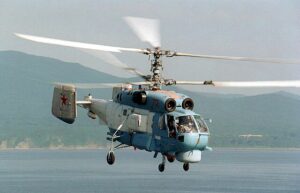 The Kamov Ka-27PS, as here (NATO reporting name ‘Helix’), was the standard SAR (Search & Rescue) helicopter, NATO Helix-D, with her ASW equipment removed and a winch fitted. Due to the attrition of Yak-38Ms they acted as plane guard at each mission.
The Kamov Ka-27PS, as here (NATO reporting name ‘Helix’), was the standard SAR (Search & Rescue) helicopter, NATO Helix-D, with her ASW equipment removed and a winch fitted. Due to the attrition of Yak-38Ms they acted as plane guard at each mission.
The earlier ships carried the Ka-25T for ASW and Ka-25PS for SAR. They were likely rerplaced by Ka-27 later in their carrer.
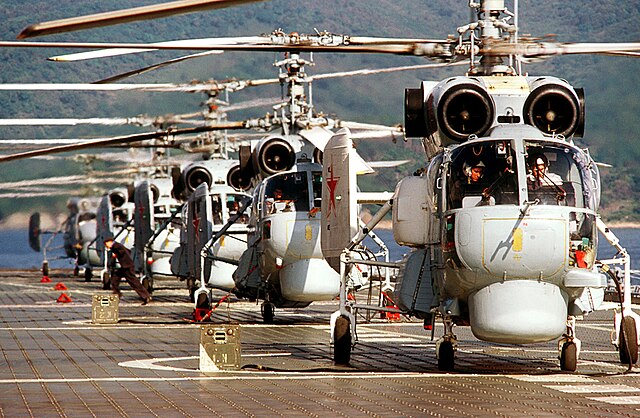
The ships if used in their amphibious warfare role were also capable of operating the Ka-29TB (NATO Helix-B) Assault transport armored helicopter. It could carry 16 troops and was fitted with wings suspensions for rockets, guns, bombs or ATGMs (1985). With seven ready to depart for the first wave, this represented 112 Marine Commandos in one go.
⚙ specifications |
|
| Displacement | 42,000–45,000 tons full load |
| Dimensions | 273 x 53/31 x 10m (896 x 174 ft oa/102 ft wl x 33 ft) |
| Propulsion | 4 shafts steam turbines, 8 turbopressurized boilers 200,000 shp (150,000 kW) |
| Speed | 32 knots (59 km/h; 37 mph) |
| Range | 7000-8000 nm at 18 knots |
| Armament | 80-200 SAM, 2x DP guns, 8 CIWS, 2×5 torpedo tubes, see notes |
| Protection | ASW bulkhead, ammo box |
| Sensors | Fregat-M, Voskhod, Volga, Vaygach, Argon, Grom-M, Turel, Vympel-A, Gurzuf, Ograda, Koltso, Platina, Orion, see notes |
| Air Group | 30, Yak-38 VTOL jets, Ka-25/27/31 helicopters |
| Crew | 1,200 to 1,600 |
General Assessment
The Kiev were combining a mixed air group, half helicopters half vertical take-off and landing aircraft. But this made for a small air wing with just twelve Yak-38 “Forger” VTOL fighters, twenty helicopters, which meant at best only six jets would be in the air at all times, and six in maintenance. At least it could bring a force multiplier through diverse missions. But all rested on the shoulders of Yakovlev, which designed the Yak-38 (NATO Forger).
Inspired by the British Hawker Harrier, the VSTOL jet proved however utterly disappointing, barely able to sustain itself in flight, let alone carrying a full armament load. For this, more were necessary to make any sort of round-the-clock combat air patrol believable. At least on paper the Kievs provided for the first time the Soviet navy a an organic fighter cover, in the 1980s, some 60 years after the first projects. Aside this midget air group, more consistent with ASW defence, they Kievs still however had an absolutely massive missile capability. They were indeed long-derived from a program making her almost a “twin” of the Kirov class. With a full battery od SS-N-12 antiship missiles, SA-N-3 surface-to-air missiles, and SA-N-4/SA-N-9 SAMs, SUW-N-1 FRAS launcher, RBU-6000 ASW mortars, they were far more powerful than contemporary US cruisers of the Virginia class generation.
 Kiev (1972)
Kiev (1972)
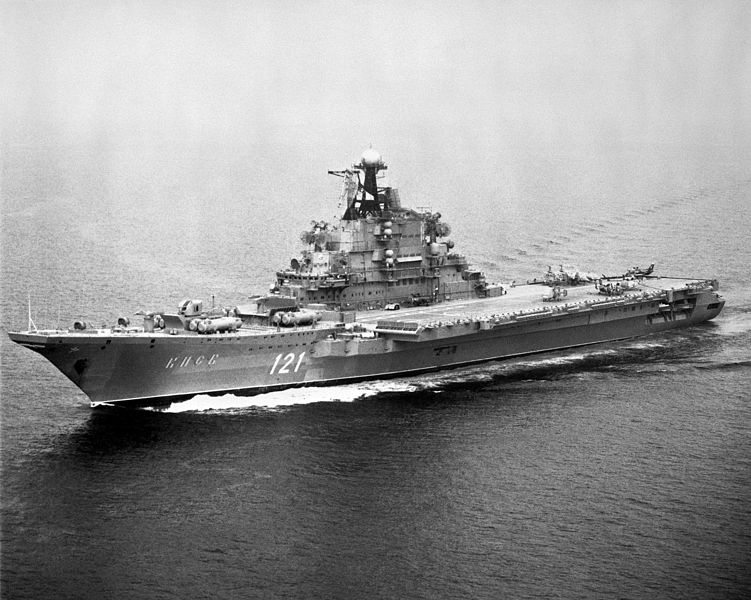
The first Project 1143 ship “Kyiv” (serial 101), had been ordered as far back as May 5, 1967, and built in the Black Sea No. 444 yard at Nikolaev starting in July 21, 1970. It depended on the cooperation on some 300 companies across USSR. She was launched on December 26, 1972 and started her sea tials on April 17, 1975, commissioned on December 28, 1975, sanctioned by Nikolaiev NyD Director A.B. Gankevich under Captain 1st Rank Yu.G. Sokolov, assisted by CiC of the Navy, Admiral of the Fleet S.G. Gorshkov whic overviewed the project from start to finish (he died before the last ship was completed).
Flight qualifications
Kiev also received the hull number “852” on the superstructure and from December 1, 1973, she saw her first her group, even before commissioned, training at Saki airfield, as the 279th separate naval assault aviation regiment. This became the first carrier aviation regiment of USSR. This went on until 1975. The first independent flight was carried out on March 3, 1975 by pilot-inspector Colonel Yu. N. Kozlov. The first regular Yak-36Ms entered the regiment in November, ten of these, making their flight qualification on land.
The Saki airfield was chosen as base for this first air group and by 1974, the 10 pilots and engineers, technical personnel were trained there on the new Yak-36M. There, special cradle girder platforms were created to train the pilots to hovering, take-off and land on a unstable platforms. On May 18, 1975 for the first time, at the Belbek roadstead near Sevastopol, test pilot Oleg Grigorievich Kononenko landed a production Yak-36M on Kiev. The was test pilot (Air Force Research Institute) Colonel V. P. Khomyakov. The third plane had to abort after a reactor failure.
On December 15, 1975, the first full-fledged flight rotation -take off, flight and landing- of a Yak-36M was trialled at the Saki airfield, then from the carrier deck on April 6, 1976.

Kiev Underway in 1981
Fleet operations 1977-1987
From July 16 to August 10, 1976, Kiev starting operation with five combat Yak-36M, one training Yak-36MU at the Northern Fleet naval base (Severomorsk). Yak-36M flights flew during her transit near Crete, Mediterranean Sea, 45 flights in all. On November 4, 1976, a new instruction regiment was formed at Saki on Yak-36M and MiG-21, with personnel from the 279th OKSHAP, Northern Fleet.
By August-December 1976, Kiev started her winter state tests weapons qualif. firing the Basalt and her electronics, radar and communication sets within fleet training, she preformed also formation flights, seaworthiness tests and it’s only by February 1977, that she was considered as fully qualified for fleet deployments. On August 11, 1977, a resolution greenlight adoption for service of the Yak-36M, redesignated Yak-38 and the training version Yak-38U. Both the ship and aircraft had indeed a common fate.
The cruiser took as permanent base Murmansk-35 in Severomorsk. Her main task was to escort SSBNs to the Atlantic up to the GIUK gap. In 1976-1982 she carried out several deployment in the Atlantic and the Mediterranean, the first being her transition from the black sea to the north sea from July 16 to August 10, 1976, Exercises “North-77” (April 12-19, 1977), a dual cruise (Atlantic+Med) from December 20, 1977 to April 4, 1978, yearly Northern Fleet exercises by August 4, 1978, third deployment from December 16, 1978 to March 27, 1979, performing a record 355 flights, then the Exercise “Run-79”, a fourth deployment from December 30, 1979 to April 28, 1980 only in the Mediterranean, a 5th from January 6 to March 15, 1981 and Black Sea Fleet exercises, a 6th from July 17 to September 18, 1981 and Zapad-81 exercises, Northern Fleet exercises, 7th deployment from July 27 to September 30, 1982 (Atlantic, Mediterranean, Baltic) and Shield-82 exercise and a screening in Soviet movie “Case in Square 36-80”.
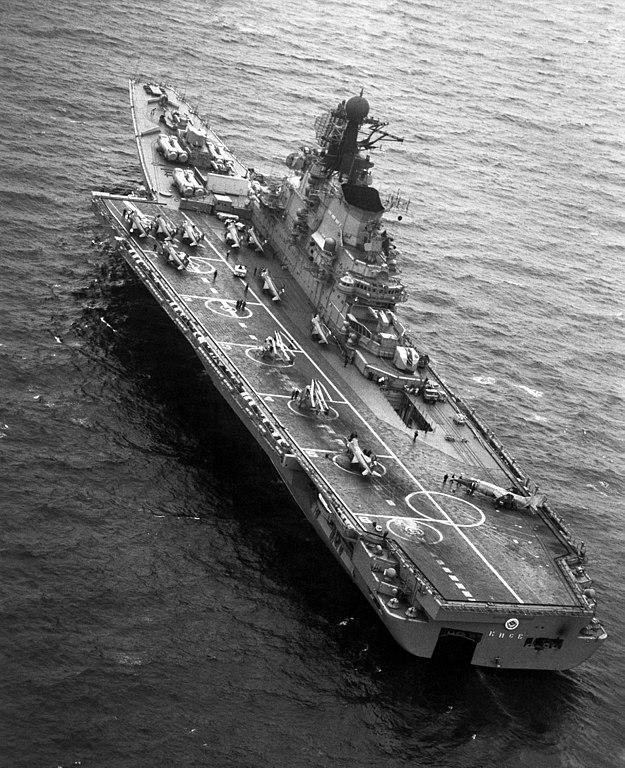
Overview of the Kiev in 1985
In 1982-1984, she had her first overhaul at Black Sea Shipyard, followed by her 8th deployment from March 20 to July 4, 1985, and Atlantic-85 exercises. While in friendly Algeria in May 1985, she was awarded the Order of the Red Banner for training excellence. It was followed by a 9th deployment from December 31, 1985 to May 21, 1986 (only two sorties) and a 10th deployment from January 5 to June 24, 1987 in Mediterranean, stopping in Split but experiencing when sailing back, a strong storm in the Bay of Biscay. A sailor went missing from the escort Bezuprechny, never spotted after a three-day search by Kiev’s helicopters. She was examined and it was found that on the eight turbines, only 2 were serviceable, so she needed a new major overhaul at Sevastopol, but after she reached Severomorsk, drydocked at Roslyakovo for early repairs.
On March 21, 1990, these were not done as the collapse of the Soviet Union was just starting. Poor safety in welding at Murmansk shipyard saw a fire breaking out, but extinguished by the crew. Damage was limited. On June 15, 1991 there was another fire which destroyed two compartments, but it was extinguished and repairs were done.
By the end of 1991, repairs were still not done and she was laid up.
Fate
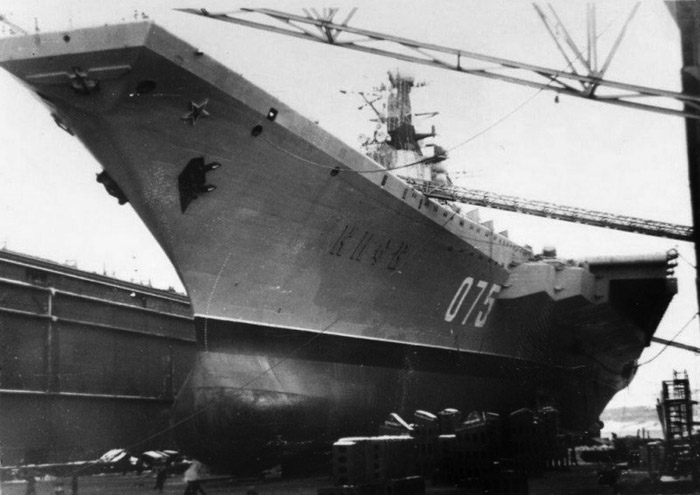
Kiev’s last overhaul
In 1993, due to the lack of funds and the lack of modernization, she was decommissioned, disarmed and sold for scrap (1.6 million dollars) to a thord party broker, that resold her for 8.2 million dollars to the Chinese government. On May 17, 2000, she was towed from Vidyaevo to Tianjin, to be officially “turned to a musum ship” and converted, but thoroughly studied by the Chinese PLAN experts and engineers. Now she sttood, abandoned and dilapidated at the Binhai Aircraft Carrier Theme Park, opening on September 2003. She had a special pier built forher used as a central entrance leading to the lobby hall, cutout on the fourth deck. The second and third decks were reconverted as exhibition rooms and playgrounds. Other rooms were repopulated with weaponry Mock-ups and some ambiance to simulate operation as well as large displays of Models of airplanes and helicopters in the upper deck and hangars.
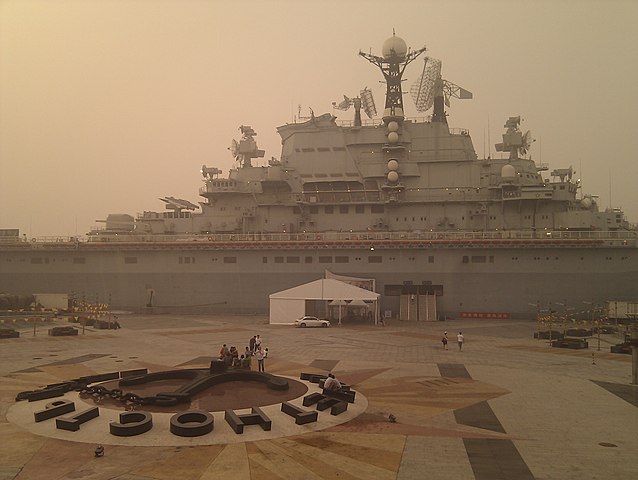
Binhai Carrier Theme Park
She opened really to visitor on April 30, 2004, with a staff of 100 people, a ticket price at 110 yuan and 40,000 weekly visitors.
In 2011, she was completely converted into a luxury hotel with 148 rooms of all classes for $15 million. However business was apparently badly managed and the hotel became bankrupt. She is now abandoned, with a few guards to stop unwated visitors and collectioners.
 Minsk (1975)
Minsk (1975)
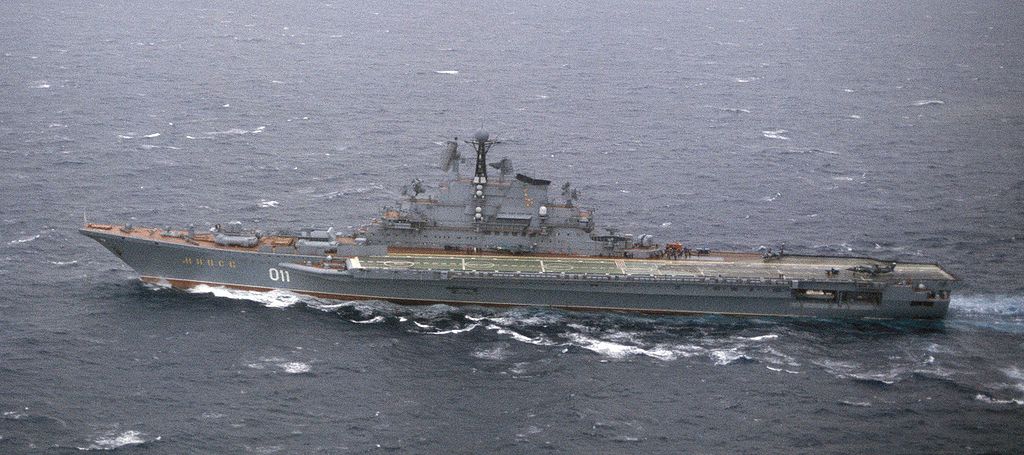
On December 28, 1972, Minsk was laid down at the Black Sea Shipyard No. 444 in Nikolaev on slipway No.0 while the yard was modernized. She was launched on September 30, 1975, and for the first time, with a fully mounted superstructure thanks to modular assembly and the new gantry being completed. She was tested in yard from October 15, 1977 to February 18, 1978, and from February 19, 1978, she was commissioned and by February 21, left for Sevastopol for her state sea trials, 3 days later.
On May 5, she tested all her weapons and controls, as well as deployed her air group fir a serie of qualification tests.
She made her tests at the same time as the Berezina integrated supply ship used for a resplenishment at sea of the Minsk. All was tried, from transferring fuel, water and cargoes plus ammunition in order to enable this capability for future oceanic deployments.
Pacific Fleet East Asia deployments
In September 1978, the State Acceptance Commission sanctioned Minsk into service, after 5 years, 9 months and 2 days from laying down the keel. By September 27, 1978, she was temporarily assigned to the 30th ASW division of the Red Banner Black Sea Fleet. She was prepared for the passage to Vladivostok and by November 1978 she made her last preparations to join the Pacific Fleet, her new assignment for the whole cold war. On January 13, 1979, she was assigned by advanced to the 175th brigade of missile ships. By February-July 1979, she made a cruise around the tip of Africa to Vladivostok, stopping at Luanda, Maputo, Port Louis, and Aden escorted by Tashkent and Petropavlovsk, Ivan Rogov adn the tanker Boris Chilikin. In the Mediterranean she met with Kiev for a two carrier task force exercise, largely mediatized. On July 3, 1979, she arrived at Strelok Bay.
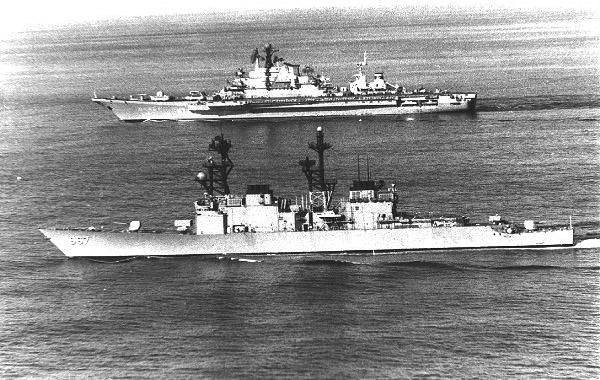
USS Elliott and Minsk in the Arabian sea, 1979
In August 1980, she started operations in the South China Sea, as a war broke up between Thailand and Kampuchea. She stopped at friendly Cam Ranh, being visited by officials. When back in October 1980, she entered the shipyard’s refitting berth at Dalzavod for a modernization until August 1982.
After refresher trials she left for the South China Sea with via Cam Ranh, and the Indian Ocean, for a port visit to Bombay and visited by an official delegation led by the Minister of Defense of India. Demonstration flights were performed for guests. She spent next the New Year 1983 at Aden, Yemen and by the fall of 1982, she received the prize of the best ship of the Pacific Fleet.
The future CiC of the Russian Navy, Vladimir Vysotsky, made his offcers debuts on Minsk, which he commanded from 1990 to 1992.
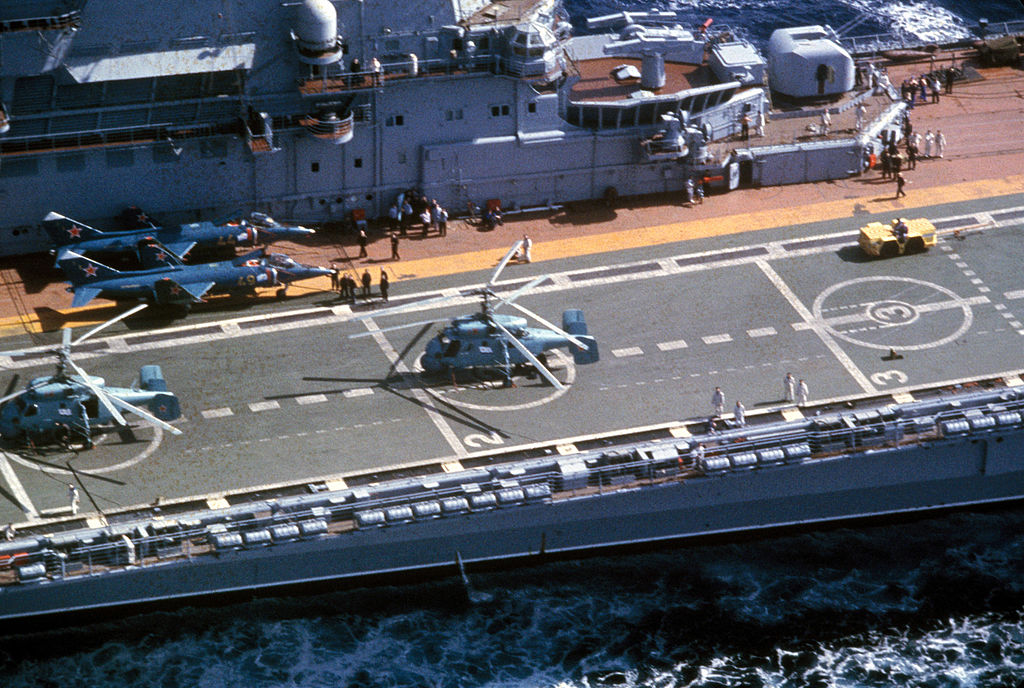
Minsk flight deck in 1986
In July 1986, Minsk stopped at Wonsan, North Korea. On February 1, 1990, while moored on the Vladivostok roadstead her bow was flooded after a depressurization of the fire-fighting system. There was no damage but the system was replaced.
From early 1991, she was prepared for a transit to Nikolaev, Black Sea Shipyard for an urgent drydock overhaul. But it was never carried out with the collapse of the USSR. She was placed in reserve at Postovaya Bay, Sovetskaya Gavan. In 1993 it was decided to decommission and disarm her, then sold her for BU after being stricken. This was done on June 30, 1993 and by October 6, 1994, she was sold to the South Korean company Young Distribution Corp, through Compass which saw also her sister Novorossiysk sold for 4.583+4.314 million US dollars.
Minsk Park
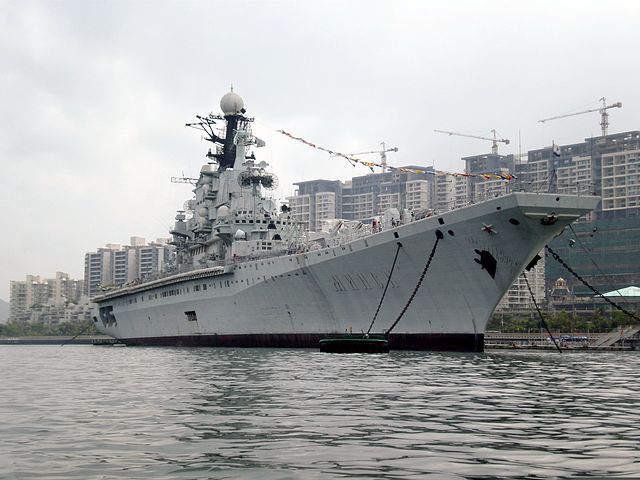
Minsk in Shenzhen
At the end of 1995, Minsk was towed to South Korea for scrapping, at least officially. In reality, she was repurchased by Chinese company created for the occasion, named the “Minsk Aircraft Carrier Industry Co Ltd”, for $5 million. In 1998 she was towed to Shenzhen, for examinations, repairs and re-equipment as a leisure complex.
In 2000, “Minsk World” museum and attraction park opened to the public after comprehensive modifications, like her sister Kiev.
On March 22, 2006, however the company met bankrupcy and tried to sell the ship in auction, but no buyer came. On May 31 there was a auction and she was sold for 128 million yuan.
Until February 2016 “Minsk World park” was located in Shenzhen until it closed. She was towed to Zhoushan for repairs and joined a new theme park in Nantong, Yangtze River, close to the entrance to the city.
 Novorossiysk (1978)
Novorossiysk (1978)
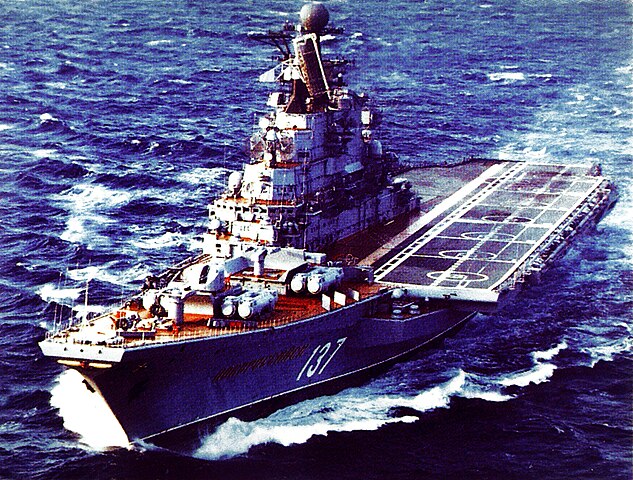
Initial plans after the construction of Kiev and Minsk were supposed to go the next step of a true aircraft carrier, but still VSTOL. Many institutes and design bureaus worked on that new design and the the construction of the third ship commenced after capitalizing on the design for the lead ship, but a completely redesigned accomodation and deck to had a full air group of 30 aircraft while the armament was modified. This new design was called project 1143M, and later Project 1143-3.
Project 1143M was approved in January 1975. On September 30, she was laid down on slipway “0”, Black Sea Shipyard of Nikolaev, where her sister Minsk was initially built. She was to be named “Baku” a new tradition for aircraft-carrying ships to take capitals of USSR republics. But Minister of Defense Grechko, suggested instead “Novorossiysk” to promot the “bestseller” widely promoted in the country (book “Small Earth” by Secretary General Brezhnev). Under the new MoD D.F. Ustinov, it was decided to stop any further improvement of VTOL ships and by a resolution of the Central Committee on February 1, 1977, construction of the 3rd ship of the Kiev class started.
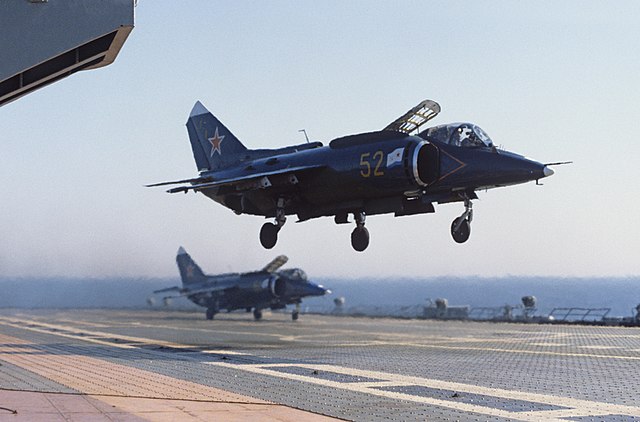
By March 1977, she was reclassified as a heavy aircraft-carrying cruiser under project 1143M (Nevsky bureau, chief designer A.V. Marinich) submitted in July 1974.
Various changes were made to the design, reflecting early lessons from her first sister, and her capabilities improved against the newly adopted cruise missile Harpoon that summer of 1977. The Nevskoye Design Bureau studied how to modernize the Kiev class, both Pr. 1143 and 1143M to preserve their combat potential, and in the end, confirmed a permanent park of 36 aircraft, improve protection against jet exhaust on the runway and increase avgas bunkerage of 50%. It was also decided to strengthen her air defense panoply, with the latest anti-aircraft missile systems, the Kortik missile/artillery complex.
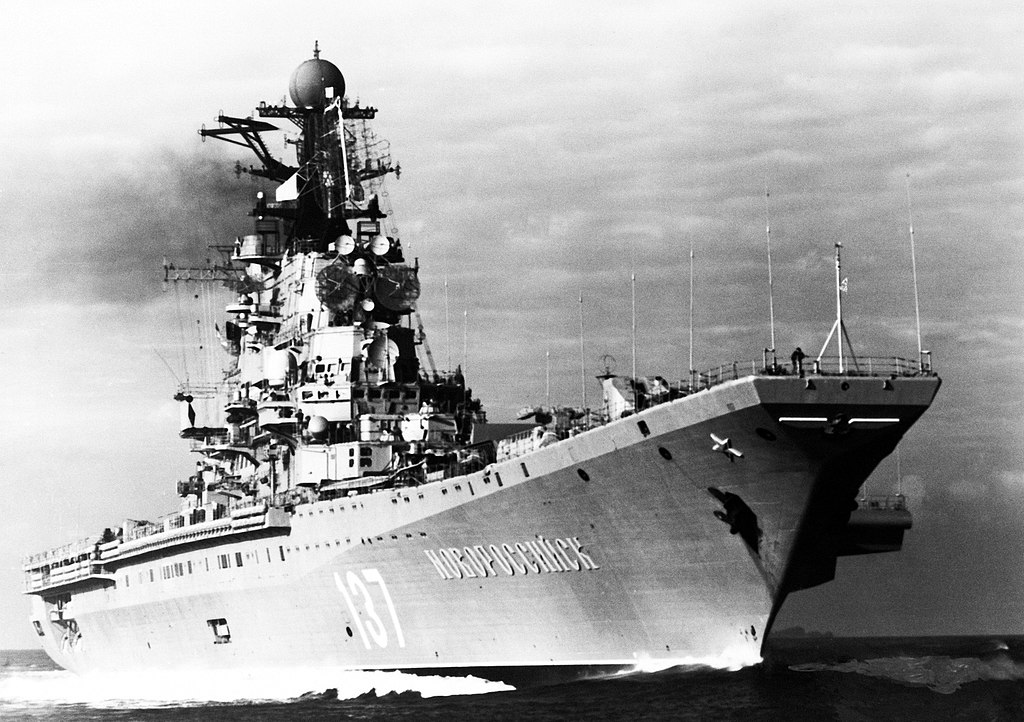
On December 26, 1978, Novorossiysk was at last launched. During completion delays started to mount for the delivery of sub-systems, and to speed things up she was never equipped with the intended Kinzhal air defense systems but fell back to the available Osa-M air defense systems. The Kortik systems were also not installed. She lacked after this any proper short-range air defense system, somewhat compensated by her greater air park. Yak-38 aircraft arrived gradually but never reached the full provision of 30 expected.
On May 14, 1983, Novorossiysk TAKR (number 137 on her superstructure) left Sevastopol for a long transit to Severomorsk in the northern fleet, arriving on June 7. She started operations with the Northern Fleet, but by October 17, 1983, she made another transit across Africa and Asia to the Pacific Fleet.
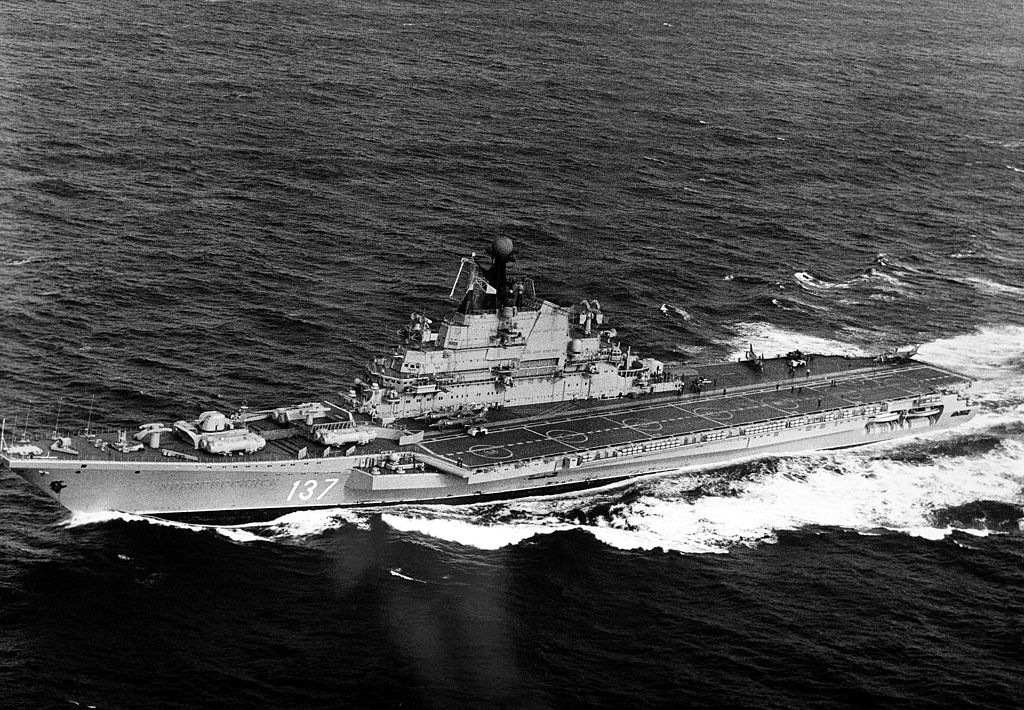
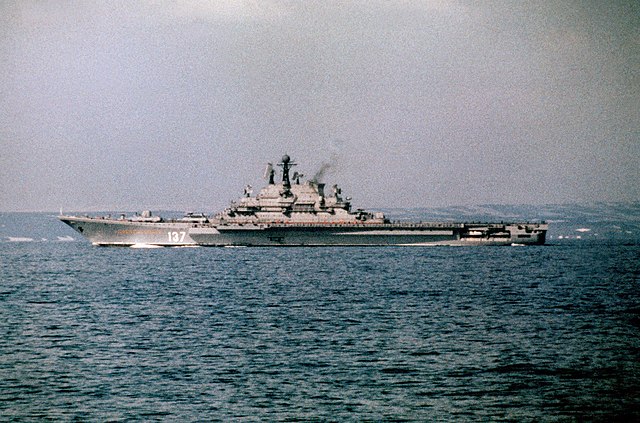
Novorossiysk in 1983
In 1983, her Yak-38 park was deposed, while waiting for the new Yak-38M (50 ordered), and waiting for the expected much better Yak-41 VTOL, nevel completed as USSR collapsed. She sailed for years without aircraft, but helicopters. She was also plagued by outdated logistics infrastructures and she was forced to stay in the Vladivostok roadstead for years until the collapse of the Soviet Unition in 1991. Her weapons and electronocs were not tested and she had a reduced crew, being in some sort of semi-reserve. Funds were lacking for maintenance, et alone modernization. Novorossiysk made her lst sortie, fully crewed, by May 1991, after a limited overhaul at Dalzavod.
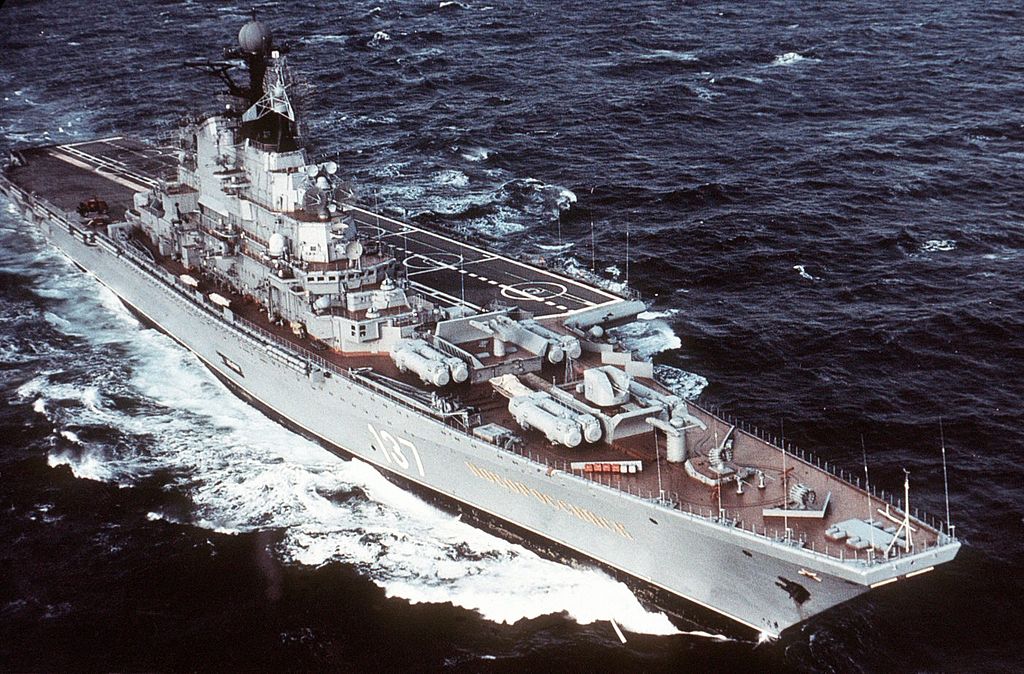
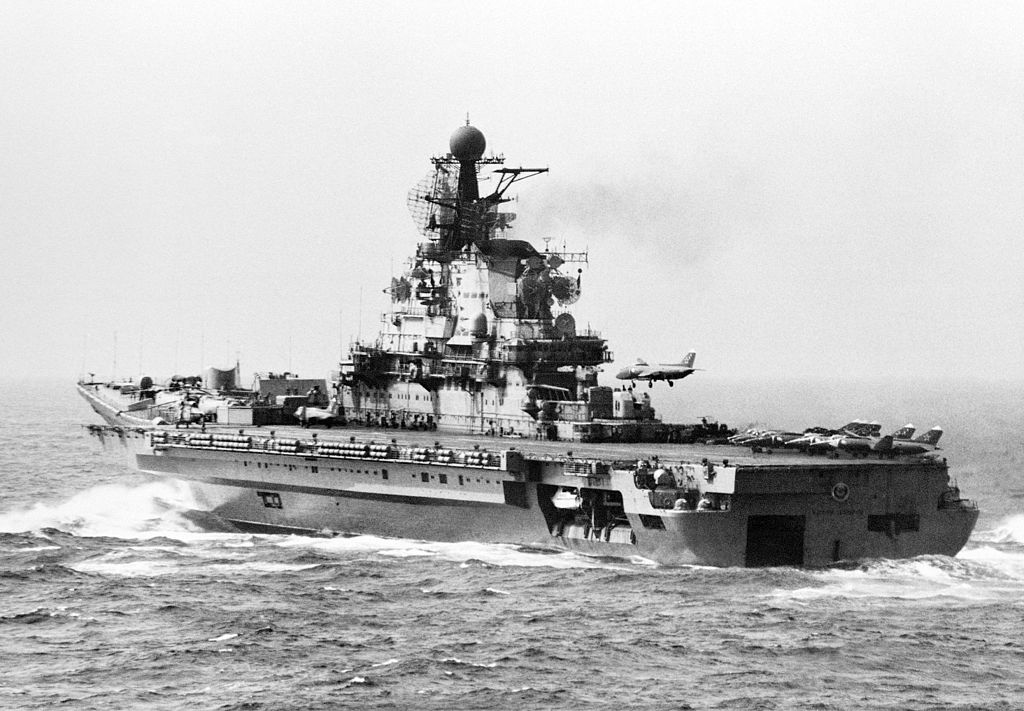
Novorossiysk in 1985 and 1986
By June 1993, the Russian Navy decided to have her disarmed, decommissioned, then stricken and sold for BU. On August 31, 1994, stricken she laid up in Postovaya Bay, Sovgavan, by January 1996 she was sold for 4,314 million dollars to the South Korean company Young Distribution Co. for scrapping, towed to Chusan in South Korea. This was done in 1997. She is the only one of the class which did not exist today in any shape or form. Her active service had been quite limited overall.
 Baku/Admiral Gorschkov (1982)
Baku/Admiral Gorschkov (1982)

These large cruisers or semi-cruisers combined the Moskva weapon system with the first reloadable cruise missile system since Project 58 (Kynda class) and Osa-M point defence system. However the deep magazine for Bazalt missiles ate a lotof internal space, the Yak-38 proved a near-disaster and they lacked the Metel’ torpedo-carrying stand-off missile although still having a sold ASW suite. Westyern analysts saw her as fit to support Soviet ballistic missile submarines deployment, free from interferences from NATO access, and this northern Atlantic presence dictated a better sea-keeping, powerful three-dimensional armament to deny all NATO ASW aircraft to approach as well as surface ships or submarines. Minsk however was deployed unlike her sister in the Pacific Fleet and neother was the thord ships, not sufficient to block the ‘GIUK Gap’.
The Novorossiysk design (Project 1143M, then 1143-3) was to provide 50% more aircraft, had a new sonar and new electronic warfare systems but her SAM point defence capabilities were poor as seen above. Also her intended Yak-41 supersonic VTOL fighters never came and she was stuck, not even with mediocre Yak 38M which were in short supply, but with helicopters. In fact, by late 1991 all surviving Yak-38 Forgers were discarded as too dangerous for use. The projected successor Yak-41 never entered production with a Yak design bureau completely broke and a flying prototype crashing, failing to find a new sponsor.
The fourth ship, Baku was again modified. Like her previous sister however, she was later renamed Admiral Flota Sovetskogo Soyuza Gorshkov. She became Project 1143-4 aimed at improving her suvivability against USN Harpoon missiles. The centerpiece of the desigh was a new phased-array radar as well as a new fighter control system. She would have also more anti-ship missile launchers, up to twelve but no reloads. The space saved helped to reinforce point defence with the Kinzhal VLS instead of Osa, but no medium-range SAM. The 76mm dual-purpose guns were replaced by 100mm single gun turrets, both forward and offset. The RBU-6000 were replaced two RBU-12000. The forward gun sponson was eliminated, the superstructure design was modified and made more compact. She had a completely new and modern electronic suite, later used on the Kuznetsov. All this impacted construction.
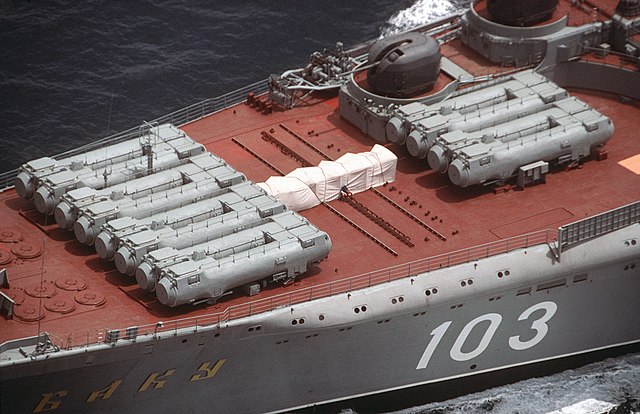
Baku was ordered to the Soviet Shipyard No. 444, Nikolayev in Mykolaiv laid down on 17 February 1978, launched on 1 April 1982 and completed on 11 December 1987. By 1990 however delays for full service acccumulated as much as bugs in her new ambitious combat system and “Cake Stand” tactical air navigation system. The air wing was to comprise by default twelve Yakovlev Yak-38 “Forger” and they did saw a few service until retired in 1992, as well as twelve Kamov Ka-27 (‘Helix-A’) ASW/SAR helicopters and two Ka-31 airborne warning (NATO Helix) helicopters.
She also was used to trial the new Yak-141 (NATO “Freestyle”) prototype.
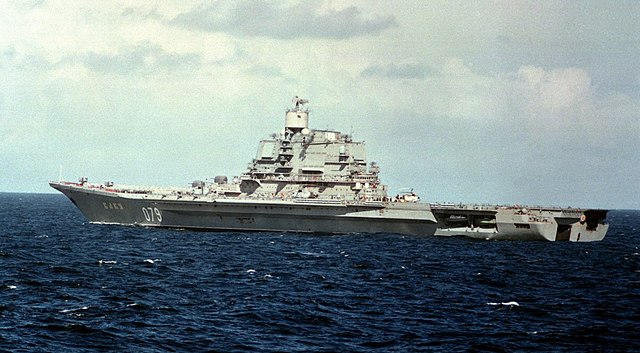
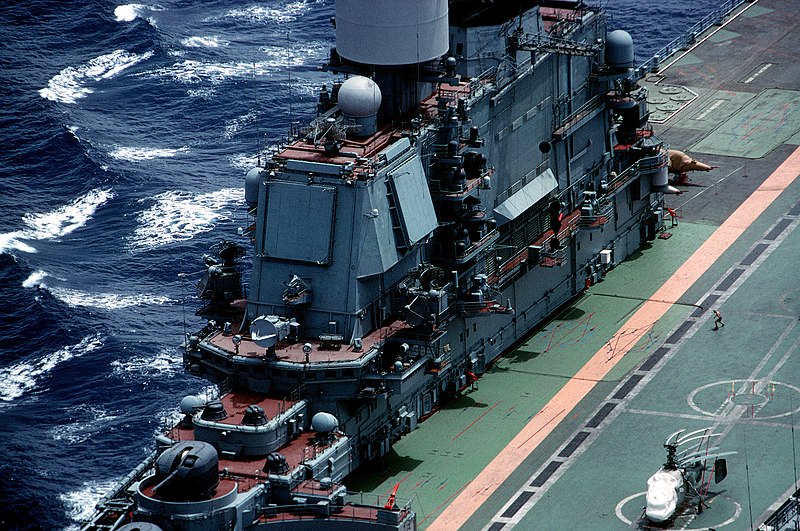
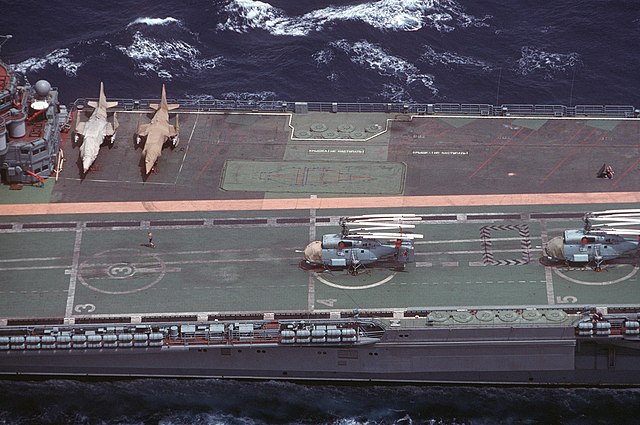
Renamed Admiral Gorshkov after the collapse of the Soviet Union in 1991 (Baku was now in independent Azerbaijan), she saw little service as vbasuic funds lacked for everything, including the crew’s pay, maintenance and supplies. Her fate is uncertain.
In 1994, the lack of maintenance caused a boiler room explosion, so she was drydocked for a year in repairs and only officially in service in 1995, to be decommissioned in 1996, stricke, offered for sale. On 20 January 2004, she was sold to India after an extensive upgrade, signed at Sevmash Enterprise. This was the most outstanding conversion in memories for such ship, as she basically was converted into a full VSTOL carrier with ski jump, an equivalent in reduction of the new Kuznetsov class. By December 2009, India paid US$2.3 billion for this, and she is in service with the Indian Navy as INS Vikramaditya, fully commissioned on 16 November 2013. Although in her new configuration she lost a large portion of her former armament, her air group is far more potent.
 INS Vikramaditya (2008)
INS Vikramaditya (2008)
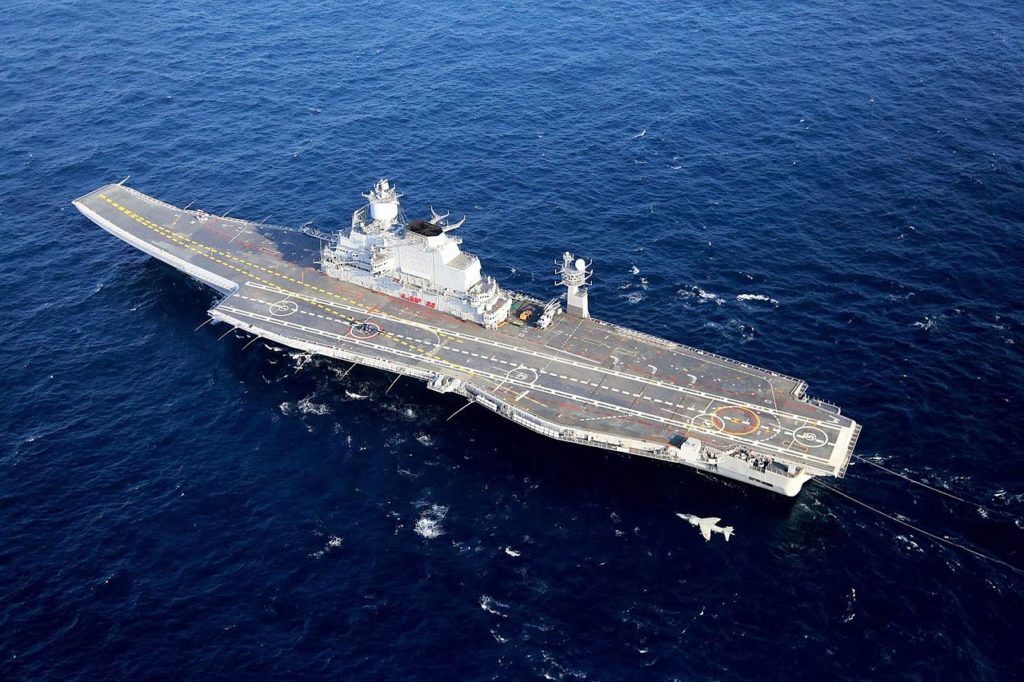
INS Vikramaditya was the former Soviet Navy Kiev-class cruiser Baku (1982), ex-Admiral Gorshkov. After the fall of USSR the new Russian Navy did not possess the budget to operate her. deactivated in 1996, the Russian gvt. had the option of either scrapping her or sell her after a modernization.
The latter was chosen as she was proposed to India, which signed a contact in 2004. The deal comprised the delivery of the ship for Free but India would pay US$800 million for its reconstruction and US$1 billion for the aircraft and weapons systems onboard. The reconstruction lasted from 2008 to 2012 and was the most extensive modernization of any large surface warship for the last 30 years. INS Vikramaditya operates today 26 Mikoyan MiG-29K multi-role fighters and 10 Kamov Ka-31 AEW&C and Kamov Ka-28 ASW helicopters for a total capacity of 36 aircraft. Still, she is considered too small for effective service and in the meantime, INS Vikrant was built, while the former is planned to be replaced by the 65,000 tonnes INS Vishal in the 2030s.
Read More/Src
Books
Jordan, John (1 April 1992). Soviet Warships, 1945 to the Present. Arms and Armour Press.
Conway’s all the world’s fighting ships 1947-95
Links
www.navycollection.narod.ru Proect_1153
http://www.webcom.com/
popmech.ru/
secretprojects.co.uk/
navypedia.org baku.htm
navypedia.org/ kiev.htm
testpilot.ru/
globalsecurity.org/ 1143.htm
hazegray.org/ /carrier.htm
globalsecurity.org/ 5sum90.htm
hazegray.org smn5.htm
ww2.dk Kiev.htm
maritimequest.com/ baku_page_1.htm
russianships.info/ 1143.htm
globalsecurity.org pr. 1160.htm
ru.wikipedia.org/
Videos
Model Kits

Lindberg 1:542, Trumpeter 1:550, WSN (Wasan) 1:550, Aoshima 1:700, HobbyBoss 1:700, Trumpeter 1:700, Yao’s Studio 1:700, BAKU by AKAMODEL 1:700, IMAI 1:1640, GHQ Models 1:2400
Main query on scalemates

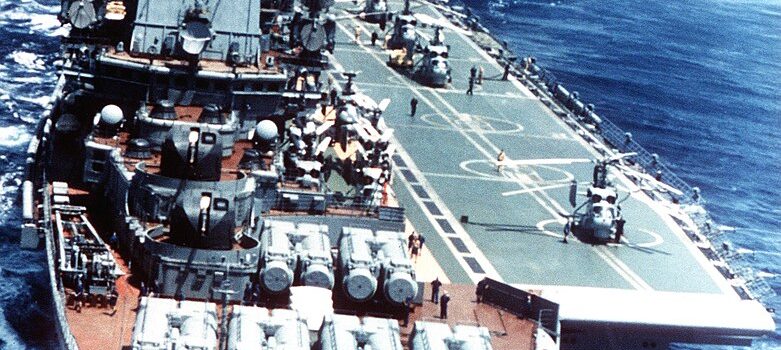
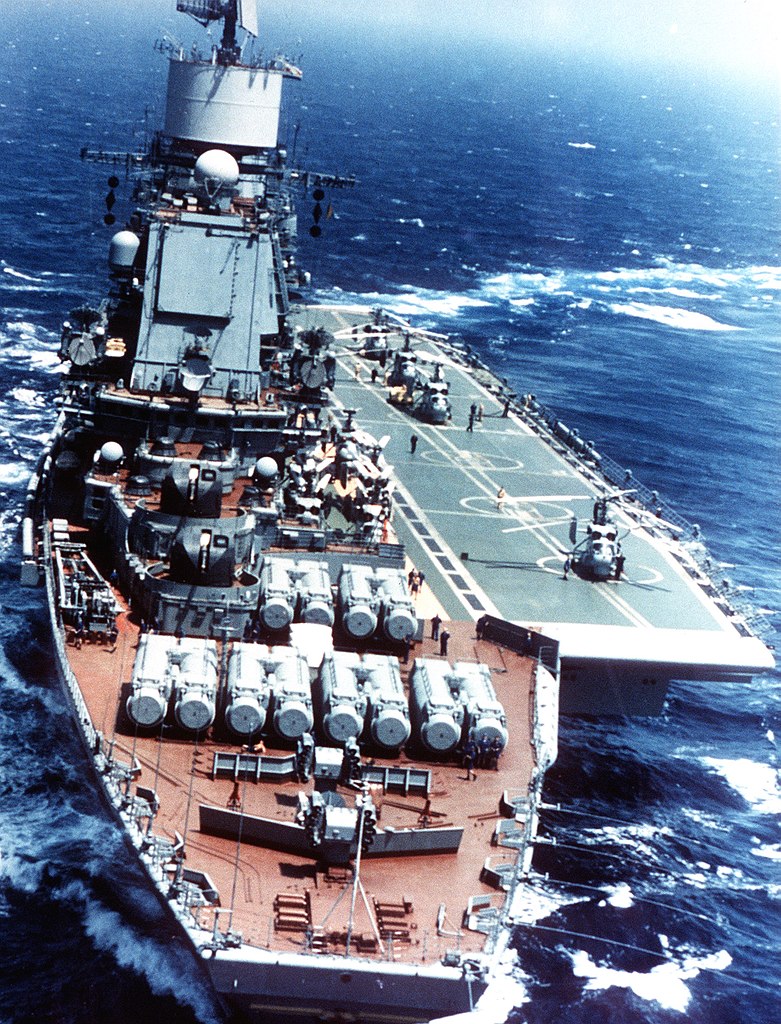
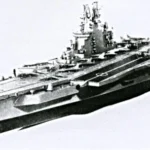
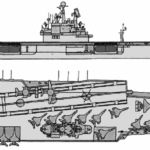
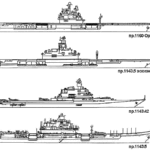
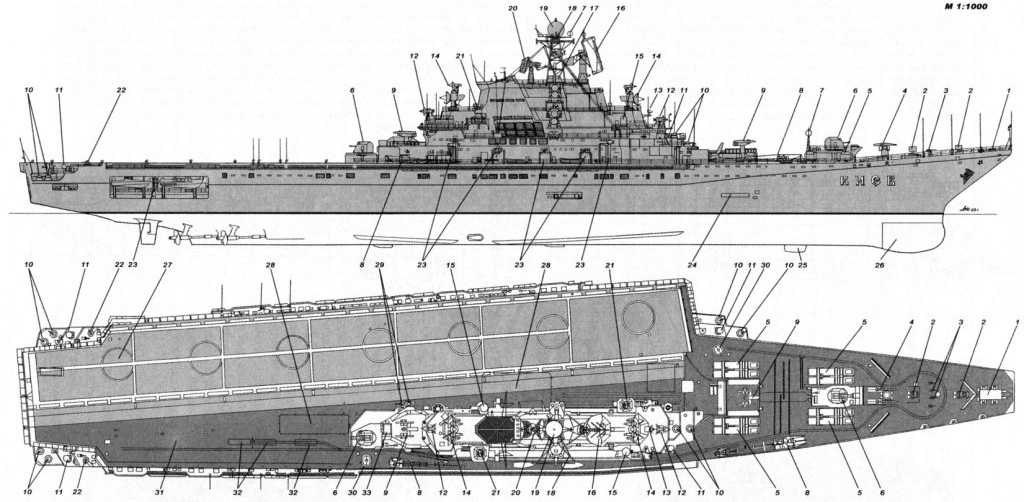
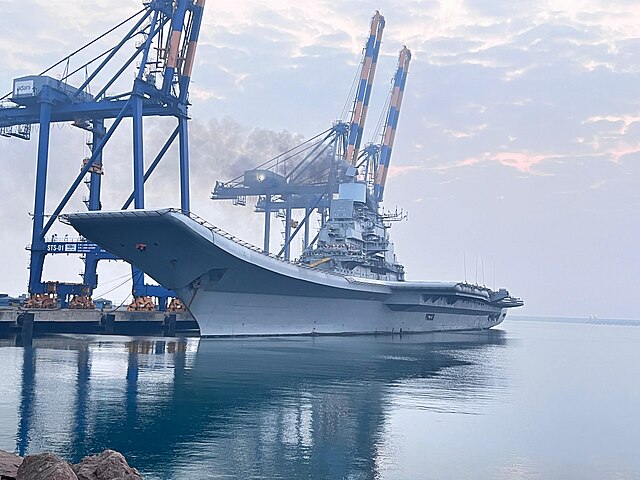
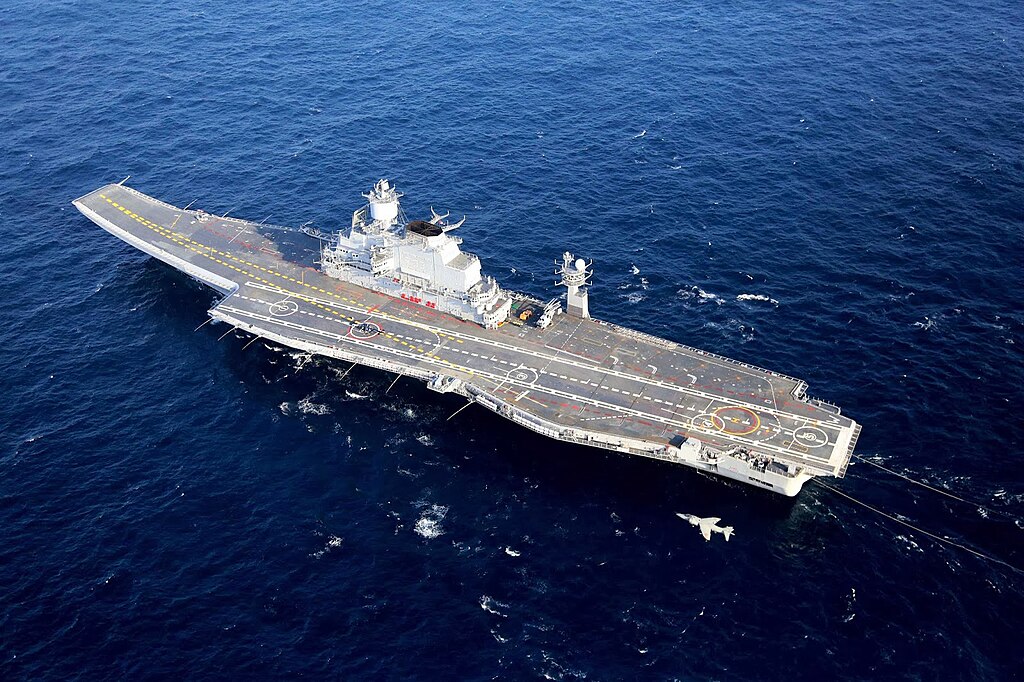

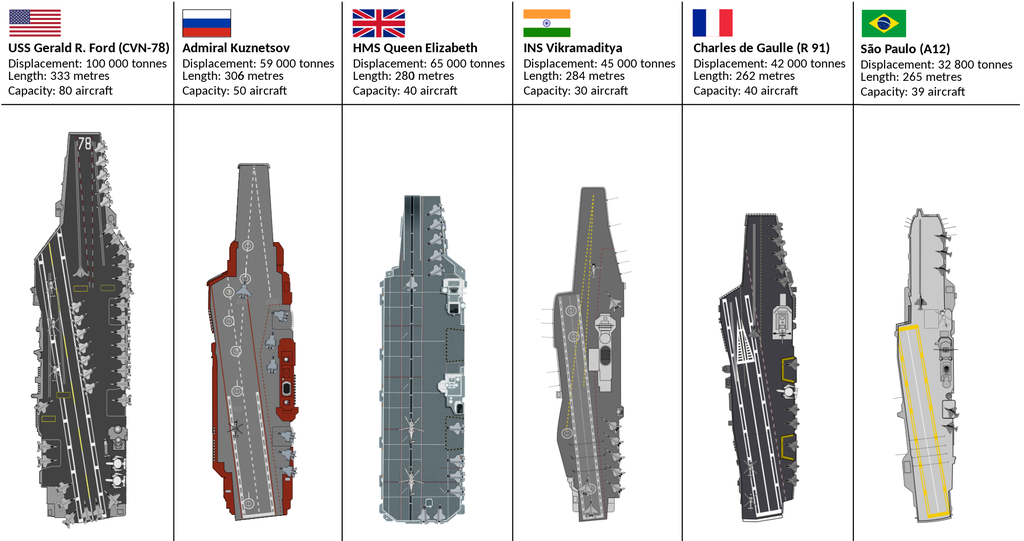
 Latest Facebook Entry -
Latest Facebook Entry -  X(Tweeter) Naval Encyclopedia's deck archive
X(Tweeter) Naval Encyclopedia's deck archive Instagram (@navalencyc)
Instagram (@navalencyc)





 French Navy
French Navy Royal Navy
Royal Navy Russian Navy
Russian Navy Armada Espanola
Armada Espanola Austrian Navy
Austrian Navy K.u.K. Kriegsmarine
K.u.K. Kriegsmarine Dansk Marine
Dansk Marine Nautiko Hellenon
Nautiko Hellenon Koninklije Marine 1870
Koninklije Marine 1870 Marinha do Brasil
Marinha do Brasil Osmanlı Donanması
Osmanlı Donanması Marina Do Peru
Marina Do Peru Marinha do Portugal
Marinha do Portugal Regia Marina 1870
Regia Marina 1870 Nihhon Kaigun 1870
Nihhon Kaigun 1870 Preußische Marine 1870
Preußische Marine 1870 Russkiy Flot 1870
Russkiy Flot 1870 Svenska marinen
Svenska marinen Søværnet
Søværnet Union Navy
Union Navy Confederate Navy
Confederate Navy Armada de Argentina
Armada de Argentina Imperial Chinese Navy
Imperial Chinese Navy Marinha do Portugal
Marinha do Portugal Mexico
Mexico Kaiserliche Marine
Kaiserliche Marine 1898 US Navy
1898 US Navy Sovietskiy Flot
Sovietskiy Flot Royal Canadian Navy
Royal Canadian Navy Royal Australian Navy
Royal Australian Navy RNZN Fleet
RNZN Fleet Chinese Navy 1937
Chinese Navy 1937 Kriegsmarine
Kriegsmarine Chilean Navy
Chilean Navy Danish Navy
Danish Navy Finnish Navy
Finnish Navy Hellenic Navy
Hellenic Navy Polish Navy
Polish Navy Romanian Navy
Romanian Navy Turkish Navy
Turkish Navy Royal Yugoslav Navy
Royal Yugoslav Navy Royal Thai Navy
Royal Thai Navy Minor Navies
Minor Navies Albania
Albania Austria
Austria Belgium
Belgium Columbia
Columbia Costa Rica
Costa Rica Cuba
Cuba Czechoslovakia
Czechoslovakia Dominican Republic
Dominican Republic Haiti
Haiti Hungary
Hungary Honduras
Honduras Estonia
Estonia Iceland
Iceland Eire
Eire Equador
Equador Iran
Iran Iraq
Iraq Latvia
Latvia Liberia
Liberia Lithuania
Lithuania Mandchukuo
Mandchukuo Morocco
Morocco Nicaragua
Nicaragua Persia
Persia San Salvador
San Salvador Sarawak
Sarawak Uruguay
Uruguay Venezuela
Venezuela Zanzibar
Zanzibar Warsaw Pact Navies
Warsaw Pact Navies Bulgaria
Bulgaria Hungary
Hungary

 Bundesmarine
Bundesmarine Dutch Navy
Dutch Navy Hellenic Navy
Hellenic Navy Marina Militare
Marina Militare Yugoslav Navy
Yugoslav Navy Chinese Navy
Chinese Navy Indian Navy
Indian Navy Indonesian Navy
Indonesian Navy JMSDF
JMSDF North Korean Navy
North Korean Navy Pakistani Navy
Pakistani Navy Philippines Navy
Philippines Navy ROKN
ROKN Rep. of Singapore Navy
Rep. of Singapore Navy Taiwanese Navy
Taiwanese Navy IDF Navy
IDF Navy Saudi Navy
Saudi Navy Royal New Zealand Navy
Royal New Zealand Navy Egyptian Navy
Egyptian Navy South African Navy
South African Navy






























 Ukrainian Navy
Ukrainian Navy dbodesign
dbodesign